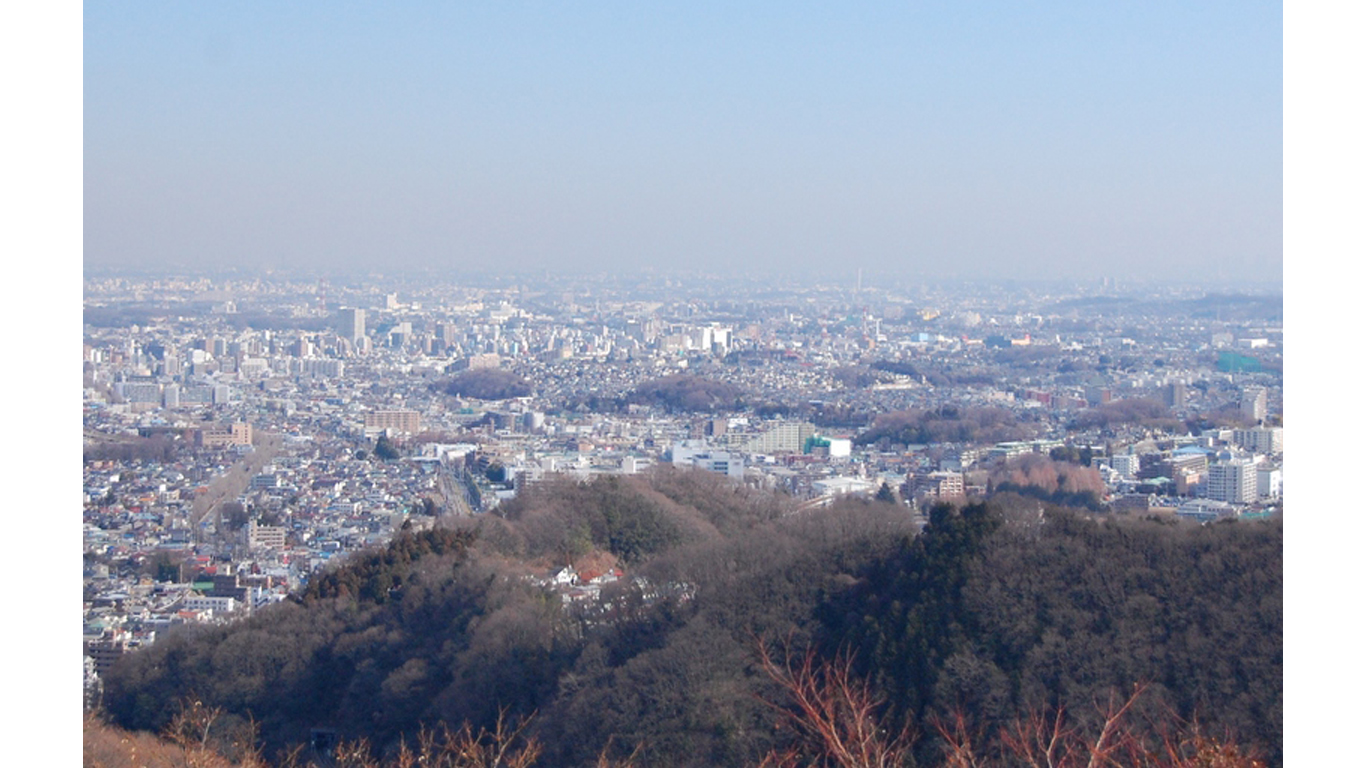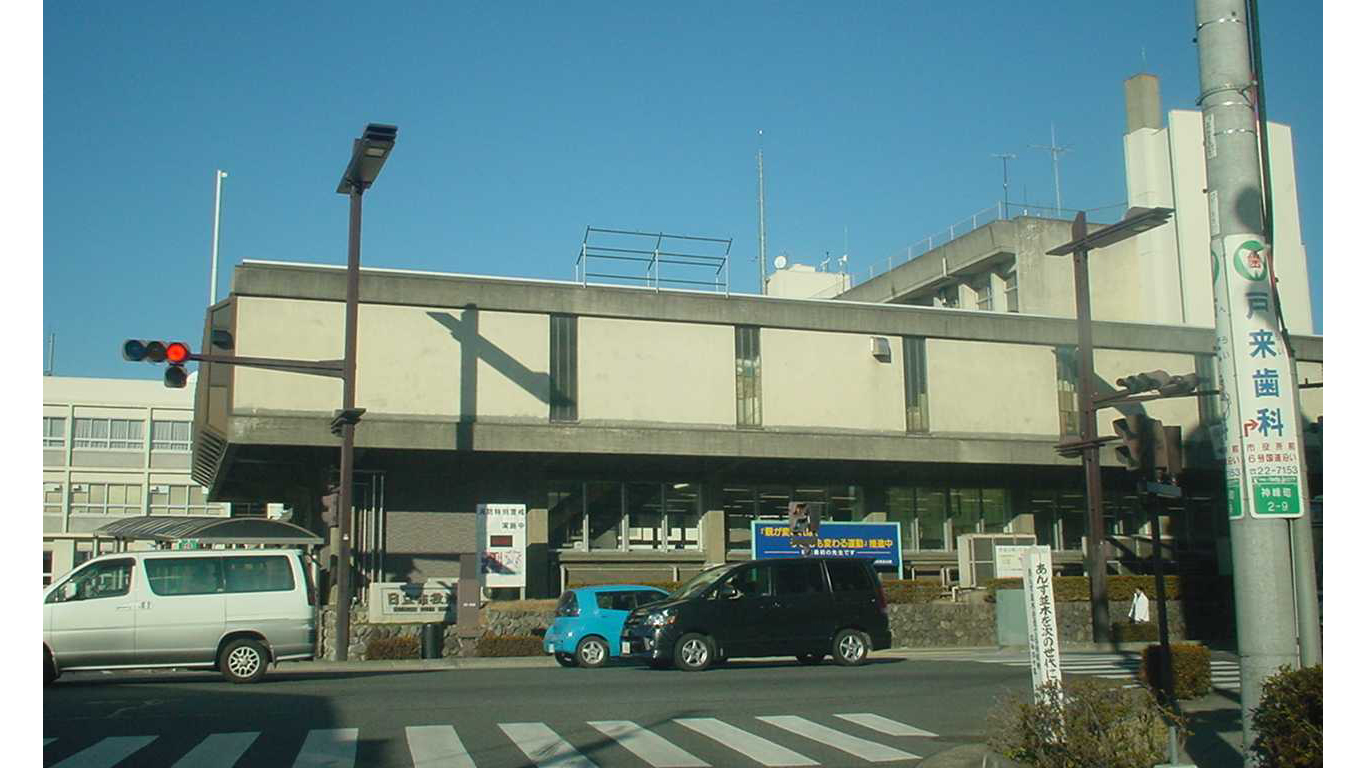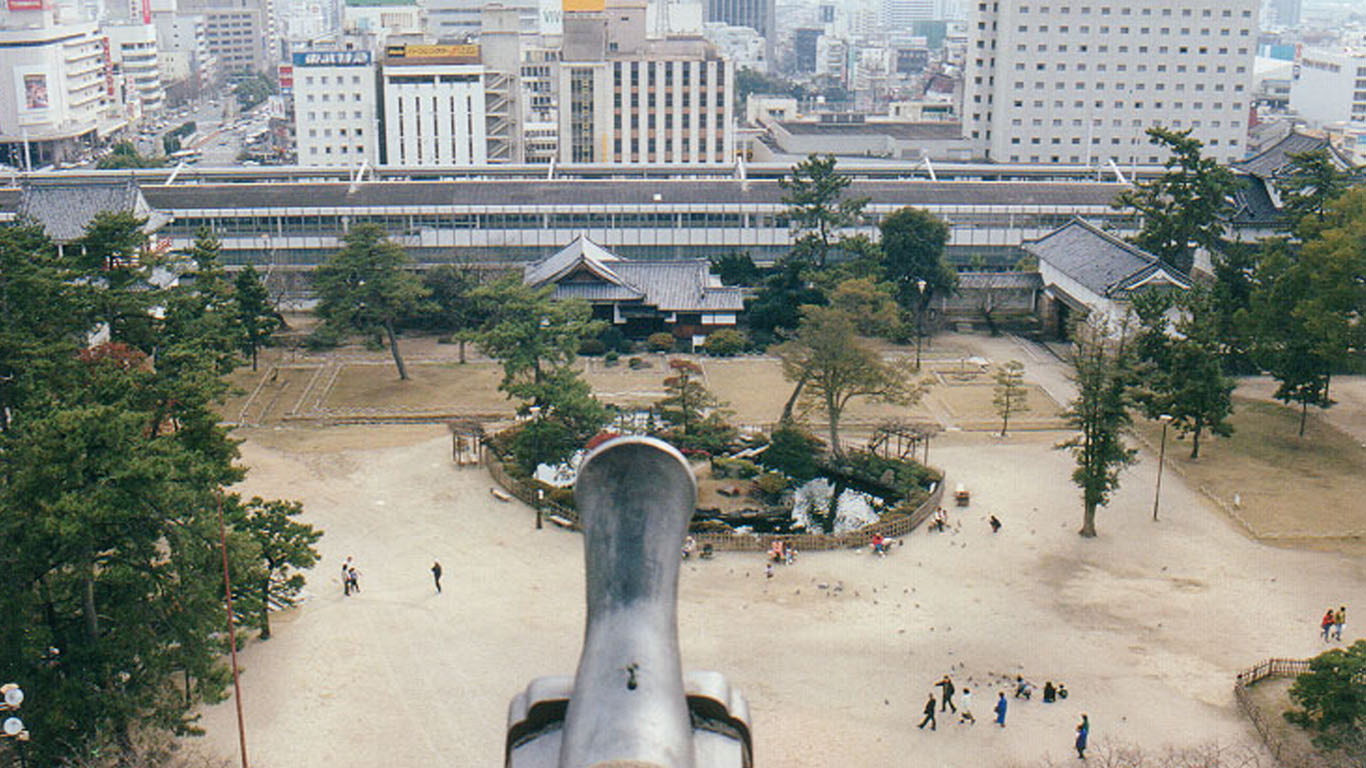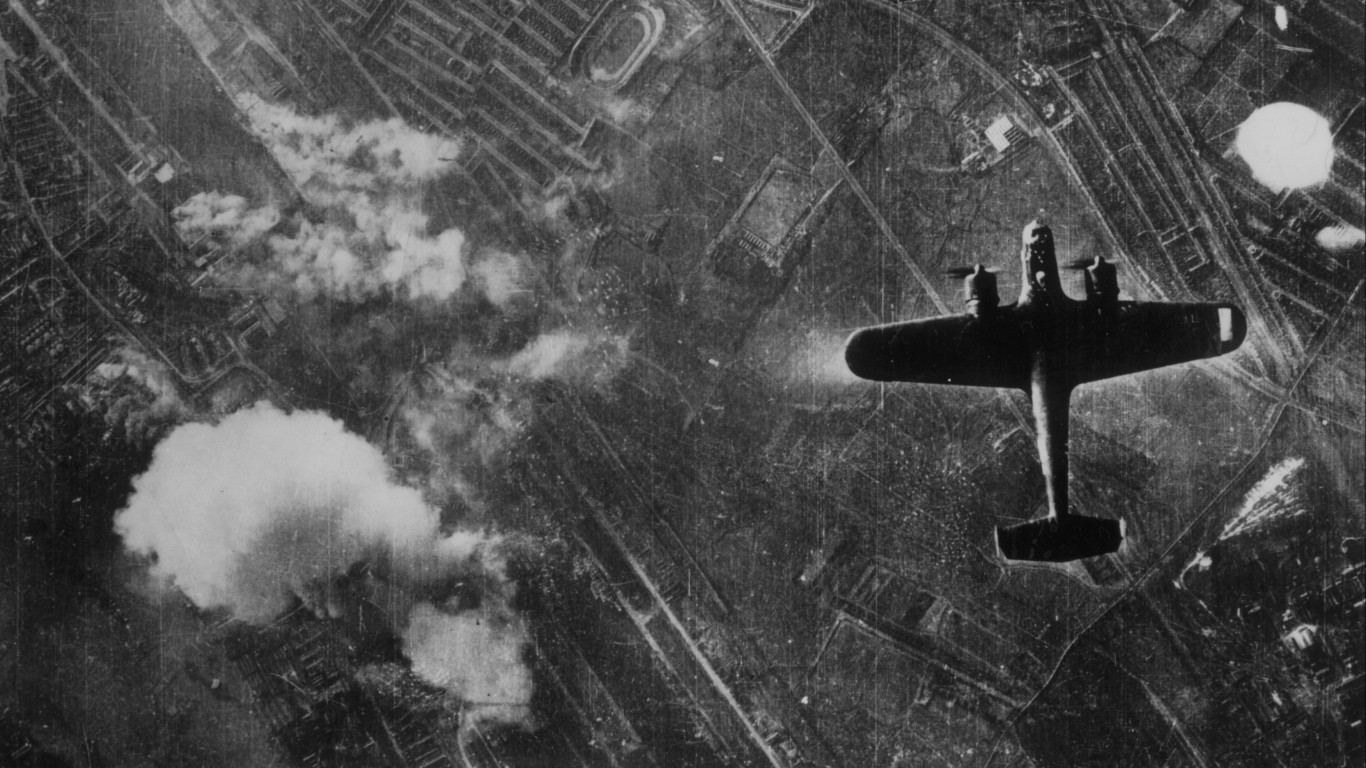
Since Russia invaded Ukraine in February, Moscow has conducted a bombing campaign aimed at its neighbor’s civilian population. The world was shocked by the strategy, but targeting civilian sectors with artillery or terror bombing from the air is nothing new. Attacks on Spanish cities by German planes during the Spanish Civil War, for instance, immortalized in the painting “Guernica” by Pablo Picasso, were a prelude to the horrors of WWII.
The U.S. was not exempt from this ruthless strategy, mapping out a bombing plan that virtually destroyed some German cities and wiped out many more in Japan.
To compile a list of cities destroyed in whole or in large part by the United States during WWII, 24/7 Wall St. used sources such as PopHistory.com, History.com, WorldHeritagesite.com, and The Guardian to compile our list. We limited our list to cities that sustained damage in excess of 50% – which excludes Berlin, where the damage was 33%. Casualty figures for some cities, in particular for Japan, were not available because of inadequate data.
The United States Army Air Forces – successor to the U.S. Army Air Corps and predecessor of the U.S. Air Force – worked in concert with the Royal Air Force to bomb German cities throughout the war. Among the major metropolises that were laid waste by U.S. air attacks were Dresden and Cologne, and an aerial attack on Berlin by the Americans marked the first military use of napalm. Allied bombing raids killed more than 400,000 civilians in Germany. (These are the countries that suffered the most civilian casualties in World War II.)
In the Pacific, American strategic bombing of Japan took place between 1942 and 1945. By August 1944, U.S. forces had captured Guam, Saipan and Tinian in the Mariana Islands south of Japan and built airfields there for its B-29 bombers. The planes would be able to make bombing runs to Japan without refueling. (These are the 18 biggest battles of World War II.)
In the last seven months of the war, napalm firebombing resulted in the destruction of 67 Japanese cities – many made of just wood and paper. As many as 500,000 Japanese were killed and another 5 million made homeless.
Click here to see the cities destroyed by the USA in World War II
Click here to read our detailed methodology
Though napalm claimed more Japanese lives than the two nuclear bomb attacks on Hiroshima and Nagasaki, those attacks overshadowed the firebombing campaign. The firebombing nonetheless remains controversial to this day. Filmmaker Errol Morris examined the topic in the 2003 Oscar-winning documentary “The Fog of War.” In the film, former secretary of defense, Robert McNamara, who provided data analysis for the American bombers attacking Japan, discussed the moral consequences of the decision to firebomb Japan and what constitute the “rules of war.”
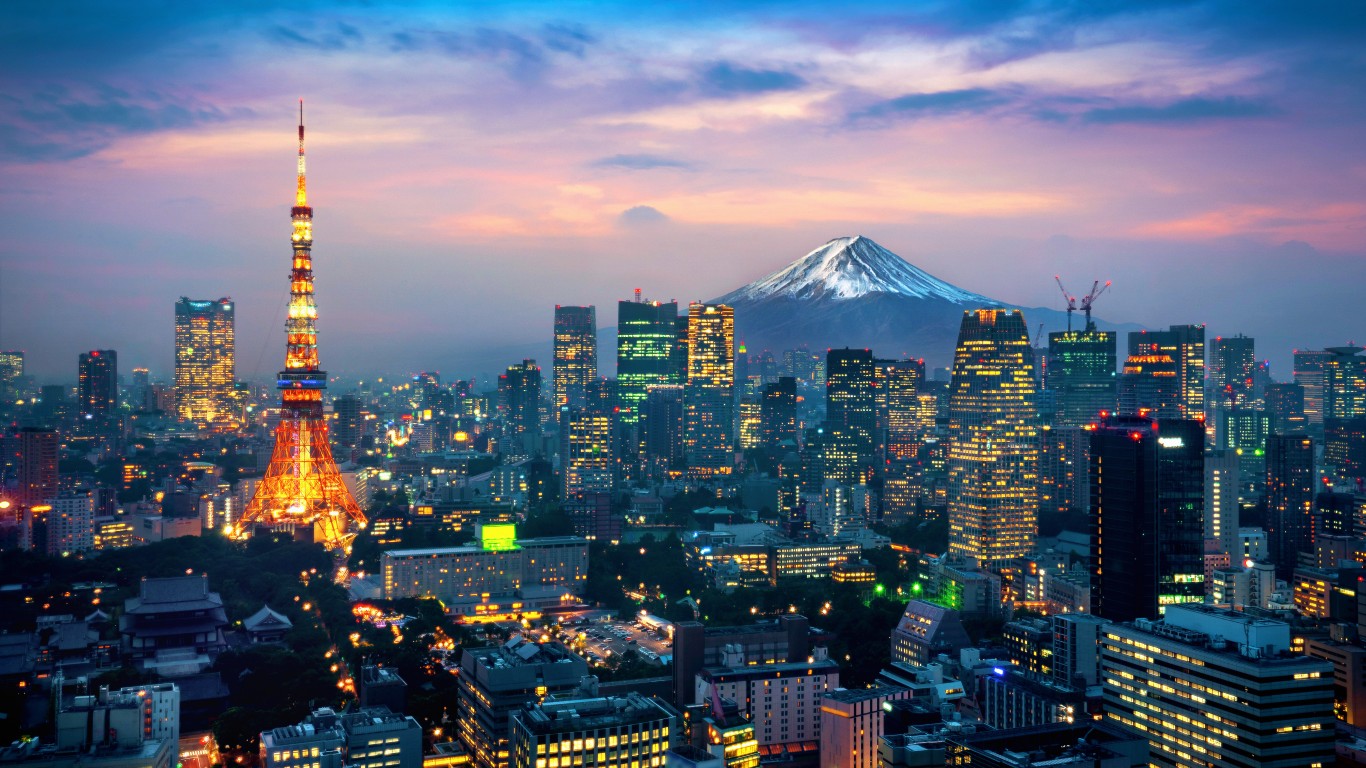
Tokyo
> Country: Japan
> % destroyed: 51.0%
> Date of attack: March 9-10, 1945
> Casualties: 124,711
Japan’s capital, with a population of about the size of New York City’s at the time, was firebombed on March 9-10, 1945. More than half of the city was destroyed.
[in-text-ad]

Frankfurt
> Country: Germany
> % destroyed: 52.0%
> Date of attack: March 26-29, 1945
> Casualties: 5,500
The bombing of Frankfurt am Main by the Allies – first the Royal Air Force and then the U.S. – killed about 5,500 residents and wiped out the largest medieval city center in Germany.

Kumagaya
> Country: Japan
> % destroyed: 55.1%
> Date of attack: Aug. 14, 1945
> Casualties: 266
Seventy-seven B-29s dropped incendiary bombs on the city where aircraft compnents were made and the Japanese Army’s air academy was located. As of the 1940 census, 45,000 people lived in Kumagaya.
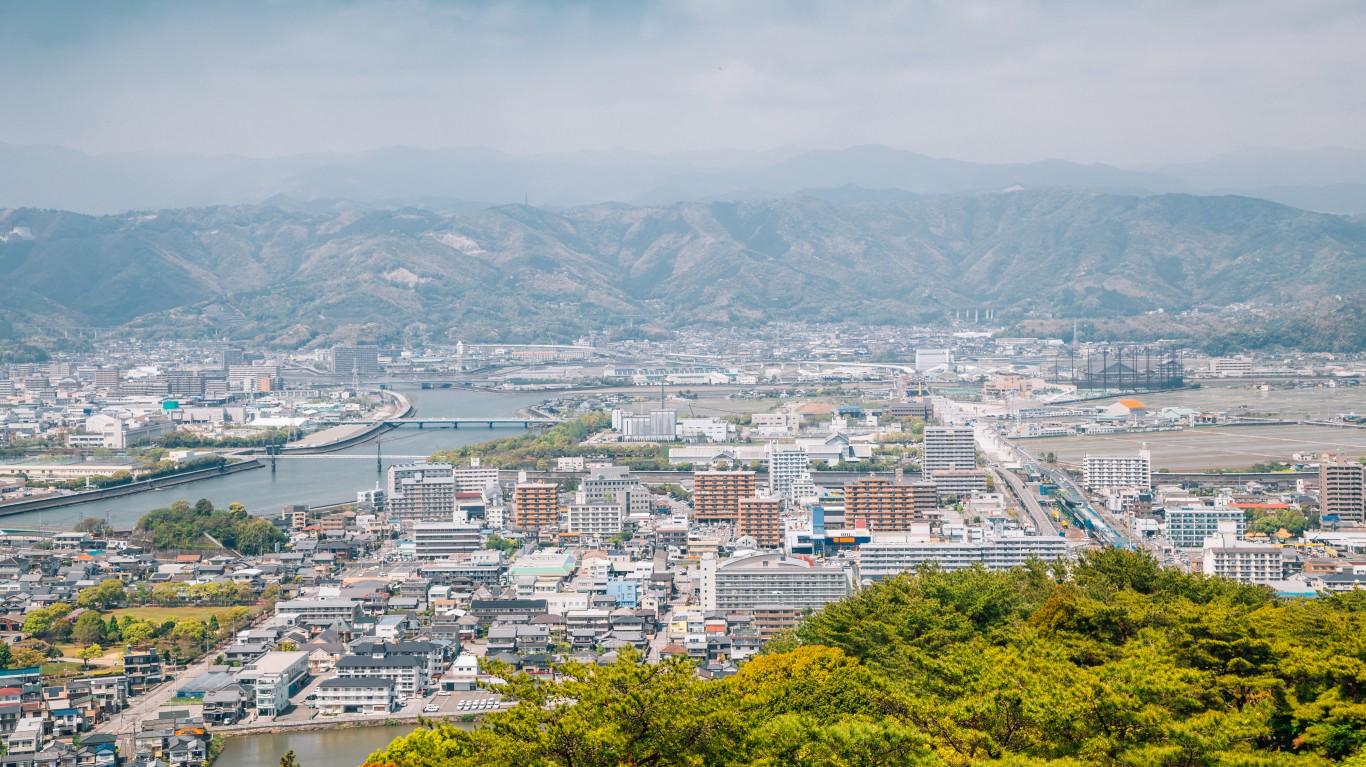
Kōchi
> Country: Japan
> % destroyed: 55.2%
> Date of attack: July 3, 1945
> Casualties: N/A
This Japanese city on the island of Shikoku, roughly the size of Sacramento, was devastated by an American air raid in July 1945.
[in-text-ad-2]

Kobe
> Country: Japan
> % destroyed: 55.7%
> Date of attack: March 16-17, 1945
> Casualties: 8,841
Kobe, about the size of Baltimore, was chosen for attack because it was the sixth largest city in Japan at the time, with a population of around a million. It also was Japan’s biggest port, with large shipbuilding and marine-engine manufacturing facilities. The city’s houses were mostly flimsy and highly flammable, so damage was extensive.
Ichinomiya
> Country: Japan
> % destroyed: 56.3%
> Date of attack: July 12, 1945
> Casualties: N/A
Ichinomiya, on the eastern coast of Japan, is a city that was about the size of Springfield, Ohio, when it was bombed in July 1945 as part of the wider strategic bombing plan by the U.S.
[in-text-ad]
Isesaki
> Country: Japan
> % destroyed: 56.7%
> Date of attack: Aug. 14-15, 1945
> Casualties: N/A
Isesaki, a city with a population of more than 213,000 today, is located 59 miles from Tokyo, in the center of the country. It was attacked on Aug.14-15, 1945, five days after Nagasaki sustained the world’s second nuclear bomb strike.
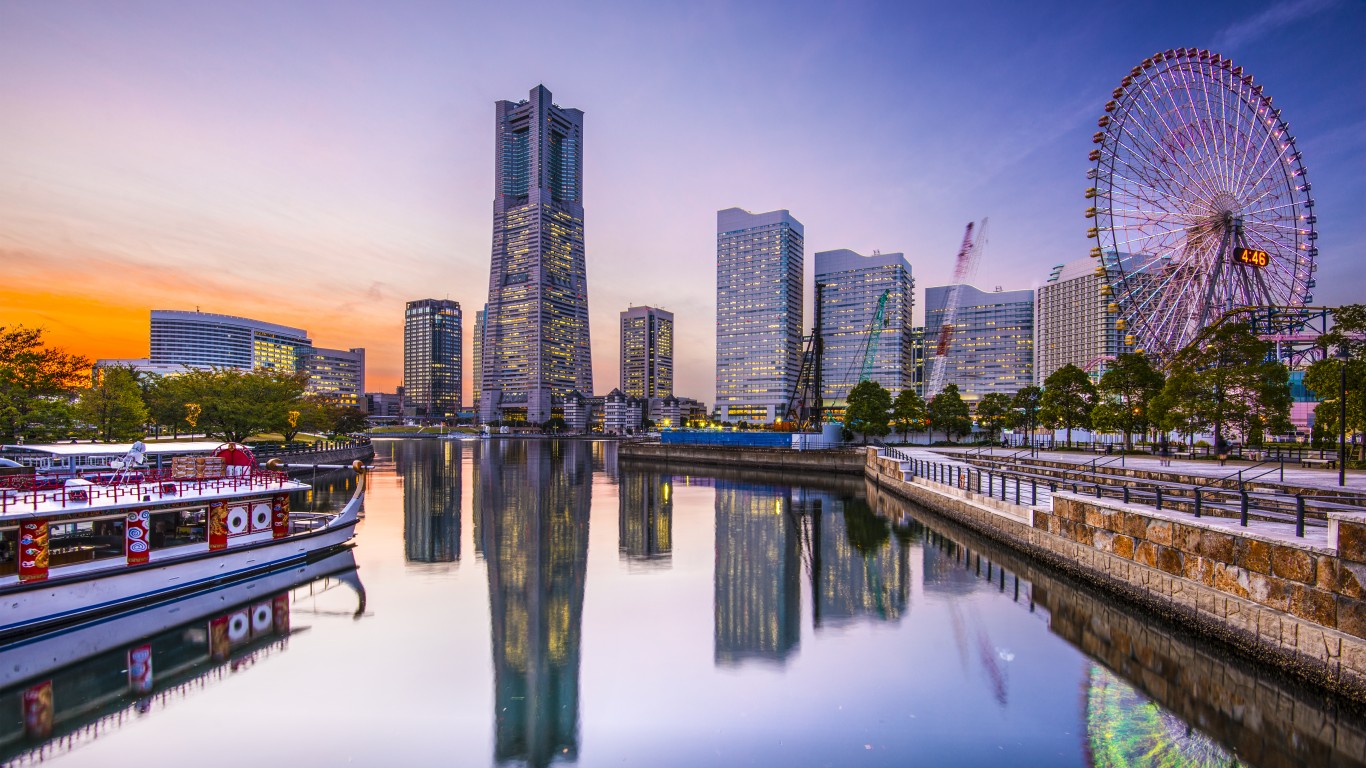
Yokohama
> Country: Japan
> % destroyed: 58.0%
> Date of attack: May 29, 1945
> Casualties: 14,157
Yokohama, a city about the same size as Cleveland, was attacked with incendiary bombs dropped by 517 B-29s, burning out 6.9 square miles. The city had been attacked earlier by the U.S. on April 18, 1942, in the so-called Doolittle Raid, retaliating for the Japanese attack on Pearl Harbor.
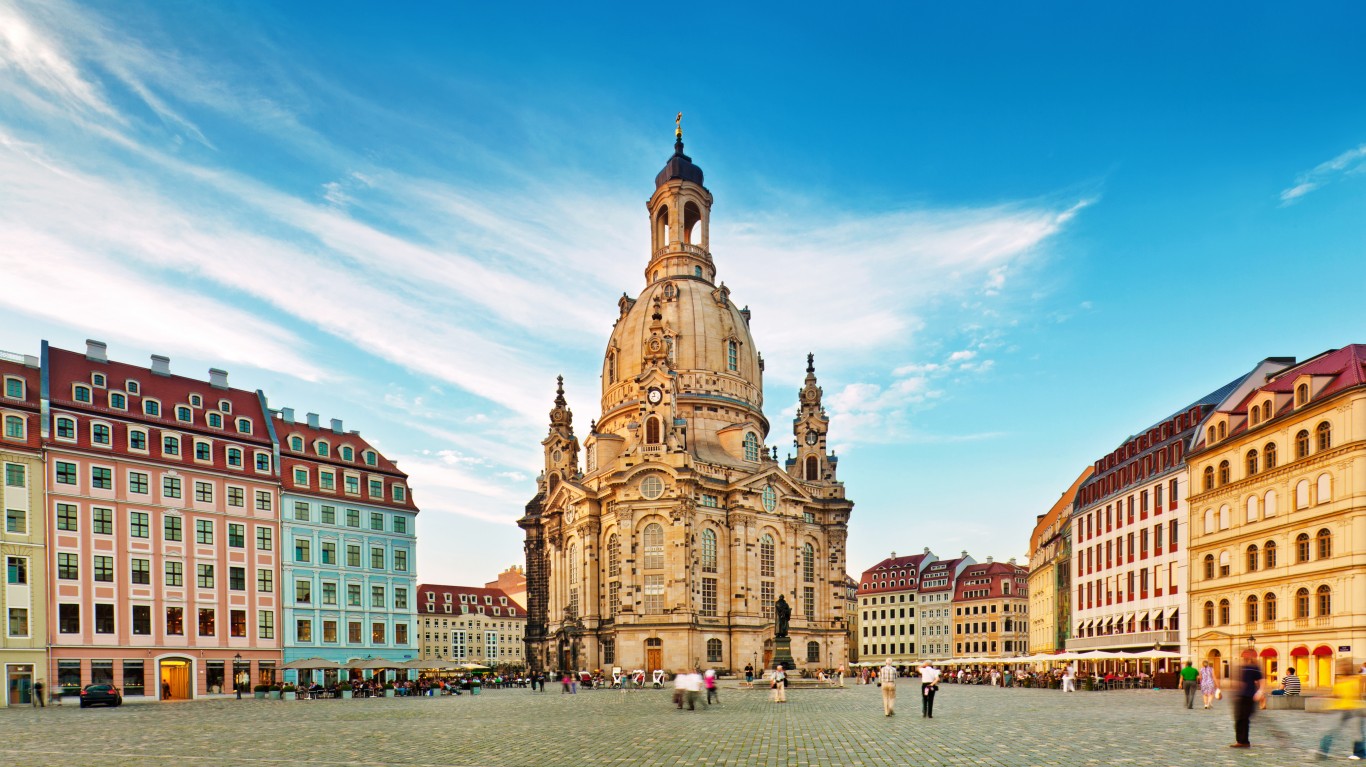
Dresden
> Country: Germany
> % destroyed: 59.0%
> Date of attack: Feb. 13-15, 1945
> Casualties: 25,000
This city in Saxony, famed for its medieval history and architecture and not considered vital to the German war effort, was severely damaged by U.S. planes in 1945. In four raids in mid-February, 772 heavy bombers of the Royal Air Force and 527 of the United States Army Air Forces dropped more than 3,900 tons of high-explosives and incendiary devices on the city. The bombing and the resulting firestorm destroyed more than 1,600 acres of the city’s center.
[in-text-ad-2]
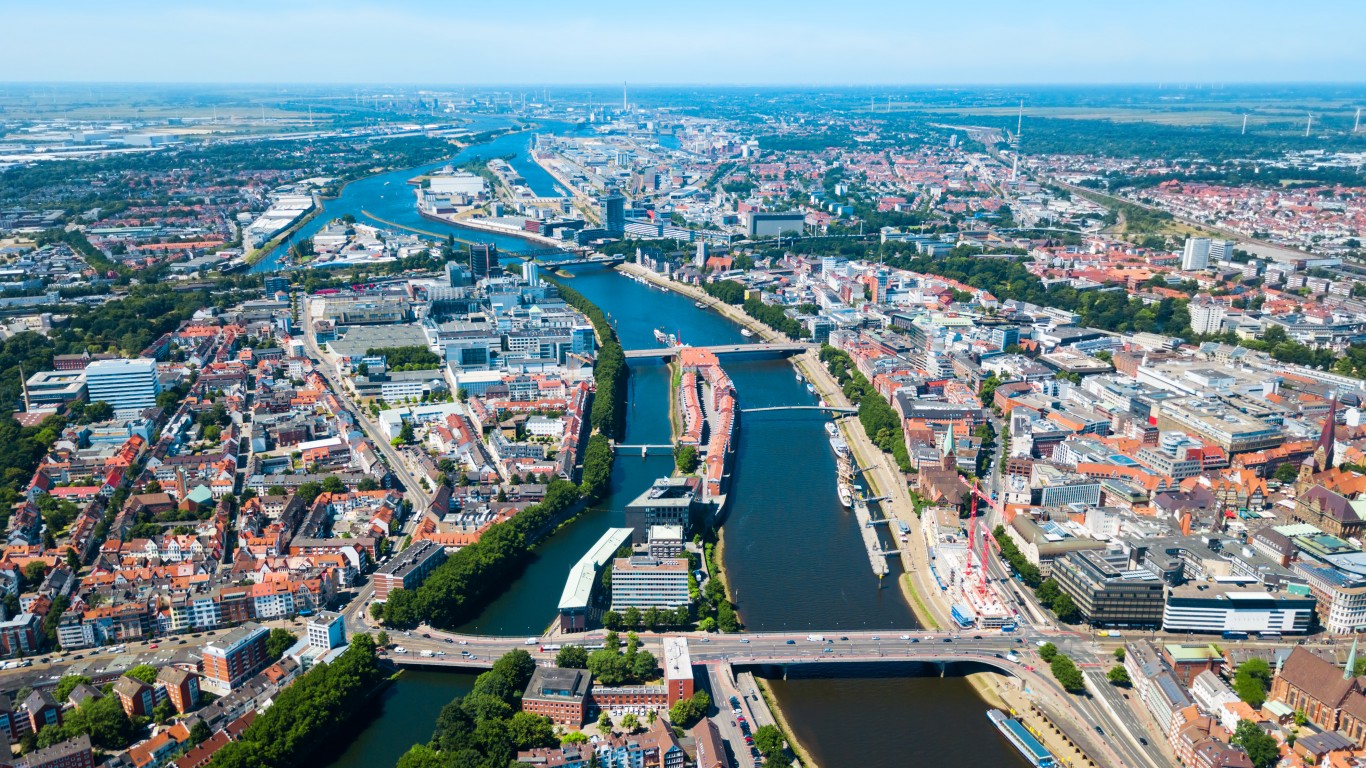
Bremen
> Country: Germany
> % destroyed: 60.0%
> Date of attack: May 1940 – April 22, 1945
> Casualties: 4,000
The German port city of Bremen was a frequent target of Allied bombing, attacked 173 times during the course of the war. The heaviest air raid hit the city the night of Aug. 18â19, 1944. In 34 minutes, 274 aircraft dropped 1,120 tons of bombs on the western portion of the city, killing 1,059 people, destroying 8,248 residential buildings, and leaving 50,000 homeless.

Hamamatsu
> Country: Japan
> % destroyed: 60.3%
> Date of attack: Feb. 15, 1945
> Casualties: 150
Hamamatsu was a major transportation hub connecting Tokyo with Osaka, with a population of 166,346. It also was the site of armaments factories and a flight school for the Japanese Army Air Force, and was on the main flight route from Saipan to both Nagoya or Tokyo. A coastal city, it was both attacked by bombers and shelled by American and British battleships.
[in-text-ad]
Toyohashi
> Country: Japan
> % destroyed: 61.9%
> Date of attack: June 19, 1945
> Casualties: 624
Toyohashi is located about halfway between Osaka and Tokyo, along the Pacific coastline in Aichi prefecture. Once known for silk making, it became a so-called military city in the early 20th century, manufacturing cannon and machine guns. The U.S. incendiary-bombed Toyohashi on the evening of June 19-20, 1945, killing 624 people.
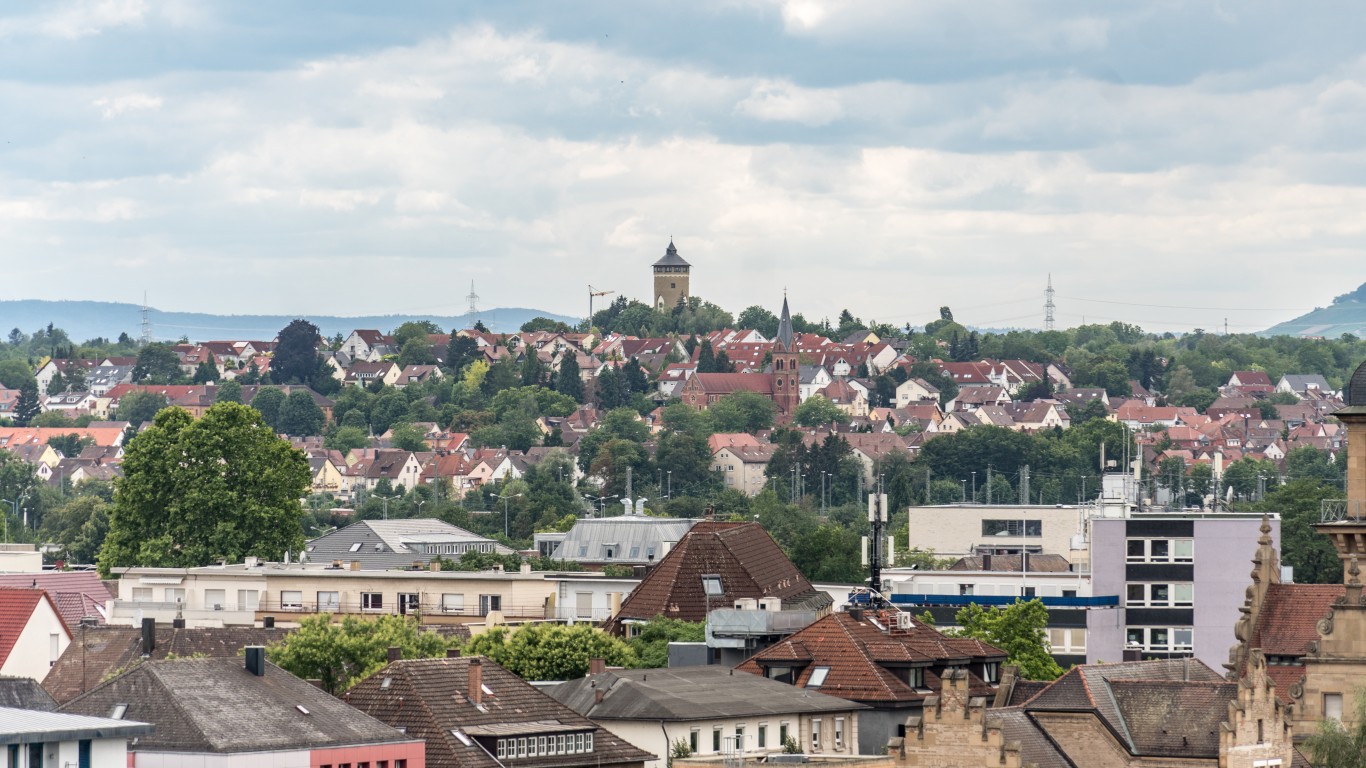
Heilbronn
> Country: Germany
> % destroyed: 62.0%
> Date of attack: December 4, 1944
> Casualties: 7,000
Heilbronn, in southwestern Germany along the Neckar River, was attacked many times by the Allies. The most lethal attack occurred on Dec. 4, 1944. Between Dec. 27, 1944 and March 31, 1945, 13 air raids hit Heilbronn.

Kagoshima
> Country: Japan
> % destroyed: 63.4%
> Date of attack: April 8 and 16, 1945
> Casualties: N/A
Kagoshima, located at the southwestern tip of the island of Kyushu, was targeted by the U.S. because of its expanded naval port as well as its position as a railway terminus.
[in-text-ad-2]

Gifu
> Country: Japan
> % destroyed: 63.6%
> Date of attack: July 9, 1945
> Casualties: 818
On July 9, 1945, 131 American aircraft dropped 907 tons of firebombs on the central Japanese city of Gifu, igniting an inferno that torched a two-mile radius in the city center. More than 800 people died, 1,200 were injured, and 100,000 were left homeless.
Imabari
> Country: Japan
> % destroyed: 63.9%
> Date of attack: Aug. 5, 1945
> Casualties: N/A
Imabari, a shipbuilding center in southwestern Japan, had been attacked earlier in 1945 by Allied bombers before a lethal attack occured on Aug. 5, 1945, the day before an atomic bomb fell on Hiroshima.
[in-text-ad]
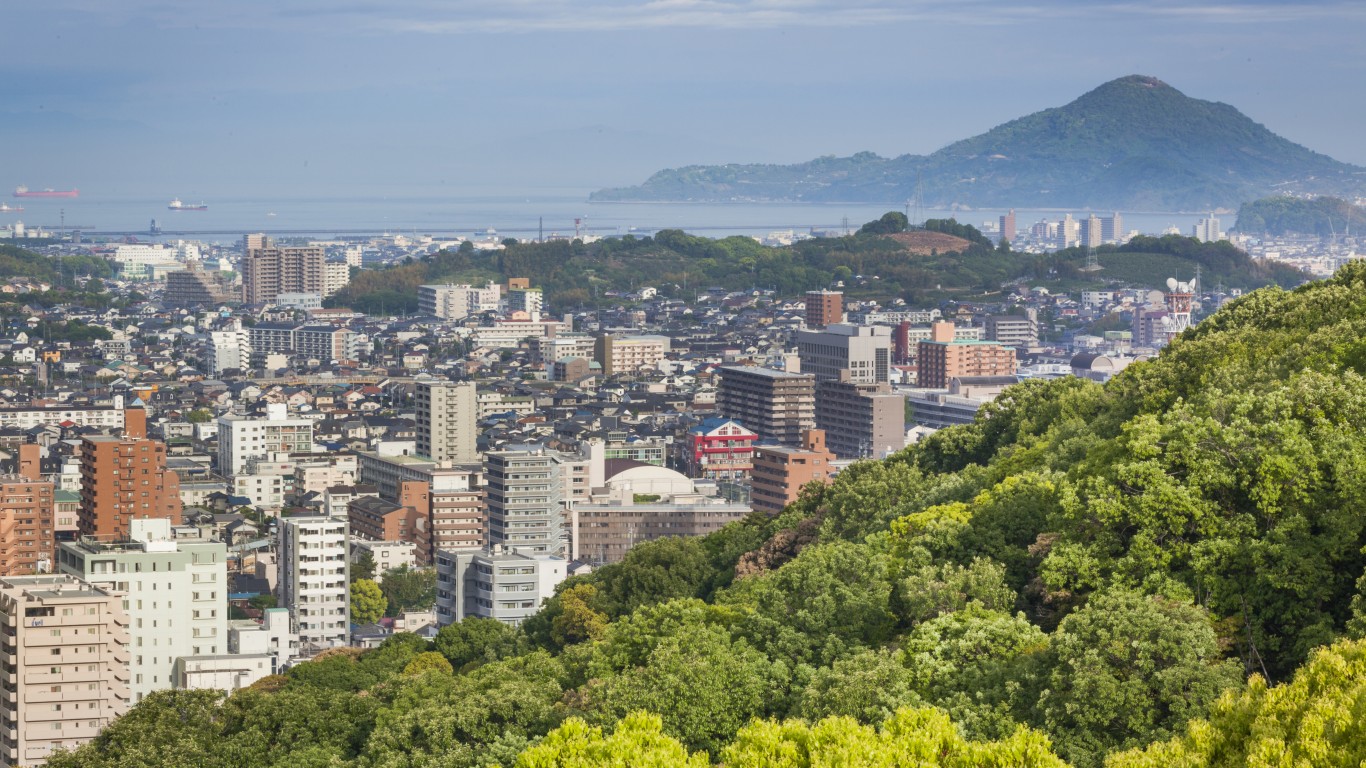
Matsuyama
> Country: Japan
> % destroyed: 64.0%
> Date of attack: Aug. 12, 1945
> Casualties: 251
Matsuyama, the largest city on the island of Shikoku, was attacked multiple times, including by a raid just days before Japan surrendered to the Allies.
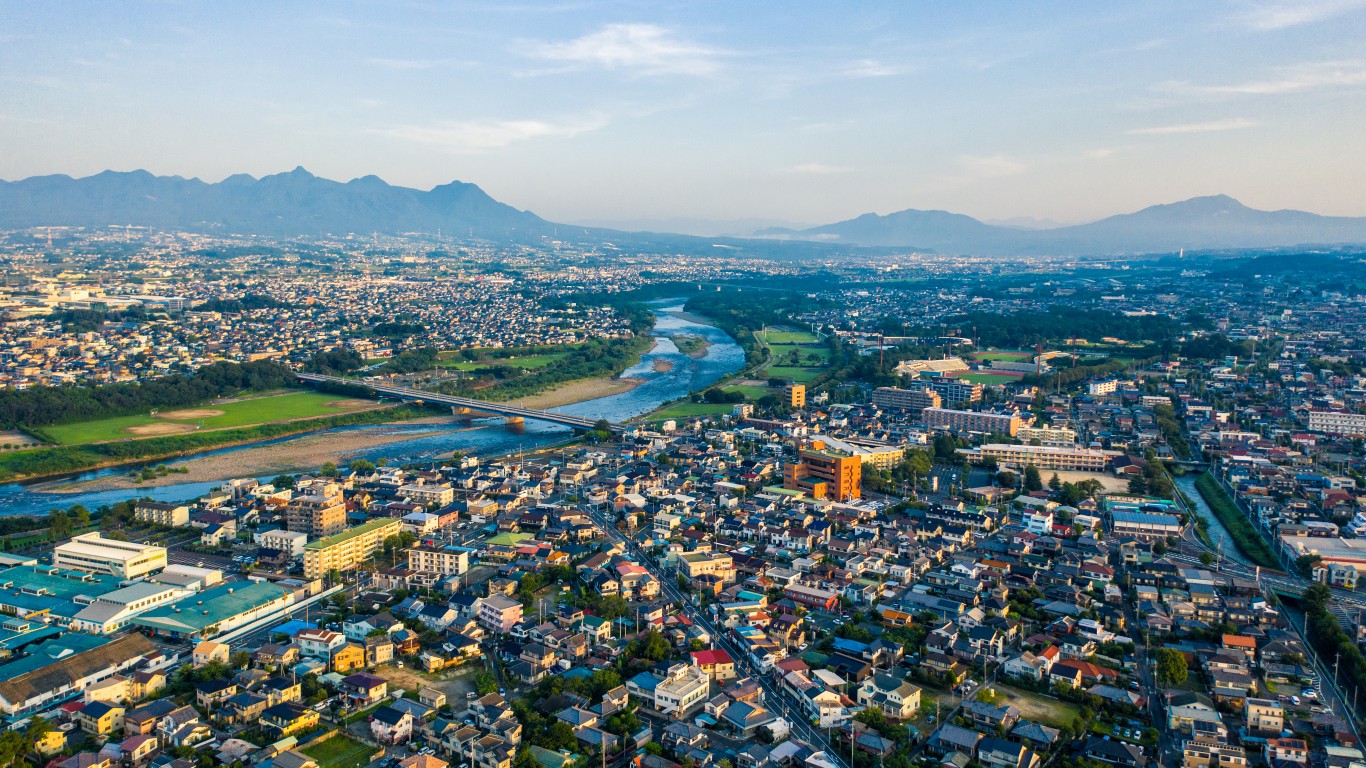
Maebashi
> Country: Japan
> % destroyed: 64.2%
> Date of attack: Aug. 5, 1945
> Casualties: N/A
A day before the U.S. ushered in the atomic age by dropping a nuclear bomb on Hiroshima, America continued with its conventional bombing strategy by attacking Maebashi. The city, in the center of Japan, was largely destroyed by Allied bombing during World War II, but it recovered and developed into an industrial and communications center after the war.

Nagaoka
> Country: Japan
> % destroyed: 64.9%
> Date of attack: Aug. 1, 1945
> Casualties: 1,486
Nagaoka was a commercial center and home to one of the laboratories of Japan’s Institute of Physical and Chemical Research. It also was the hometown of Japanese Admiral Isoroku Yamamoto, who planned the attack on Pearl Harbor. On Aug, 1, 1945, 125 B-29s struck the city with an estimated 163,000 incendiary bombs totaling 925 tons. The raid lasted for 1 hour and 40 minutes.
[in-text-ad-2]
Hachiōji
> Country: Japan
> % destroyed: 65.0%
> Date of attack: Feb. 9, 1945
> Casualties: N/A
Hachiōji is in the foothills of the Okutama Mountains, which surround it on three sides, about 25 miles west of Tokyo. It was heavily damaged in early February 1945, and attacked on other occasions during the war, but was rebuilt and grew as a Tokyo suburb.
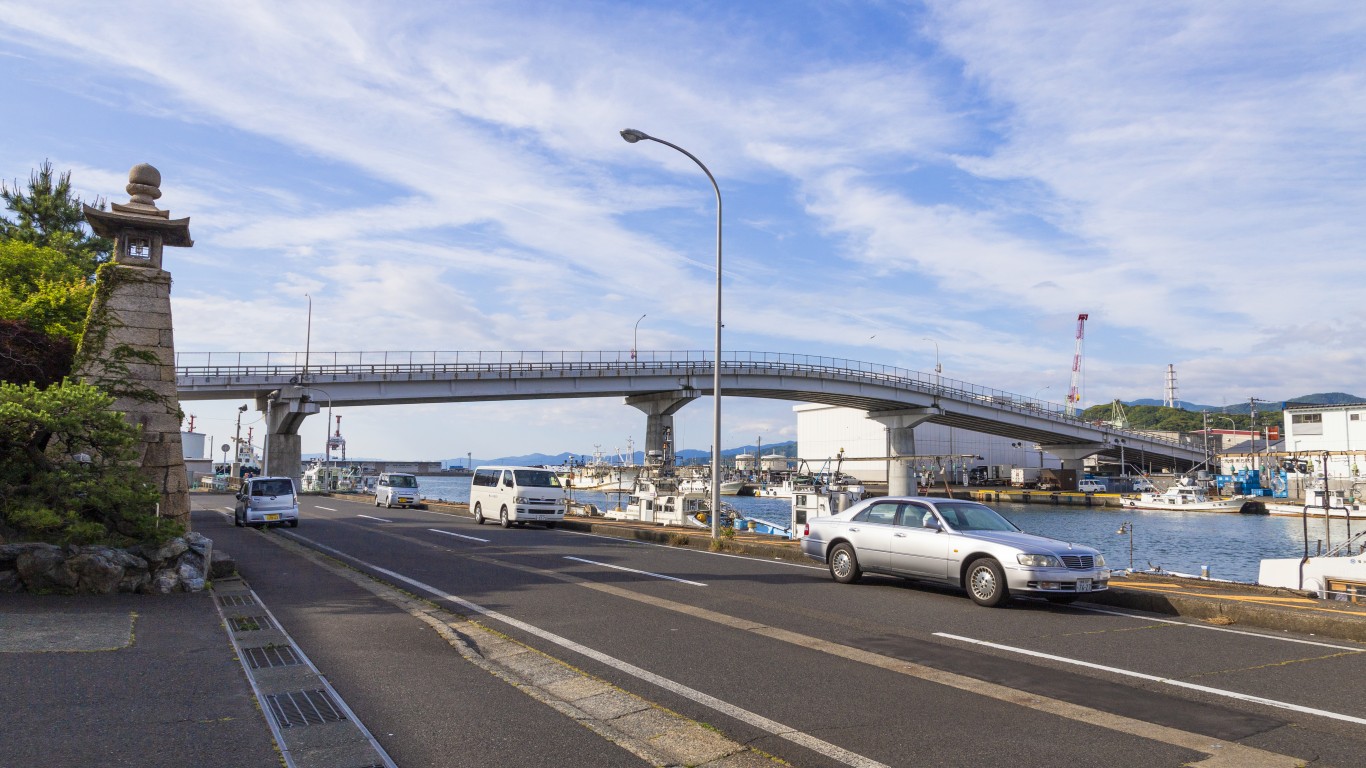
Tsuruga
> Country: Japan
> % destroyed: 65.1%
> Date of attack: July 12, 1945
> Casualties: N/A
Tsuruga became the first city of the Sea of Japan coast to be targeted by air raids on the night of July 12, 1945. The city’s defenses were inadequate, and more than 65% of Tsuruga was razed by incendiary bombs.
[in-text-ad]
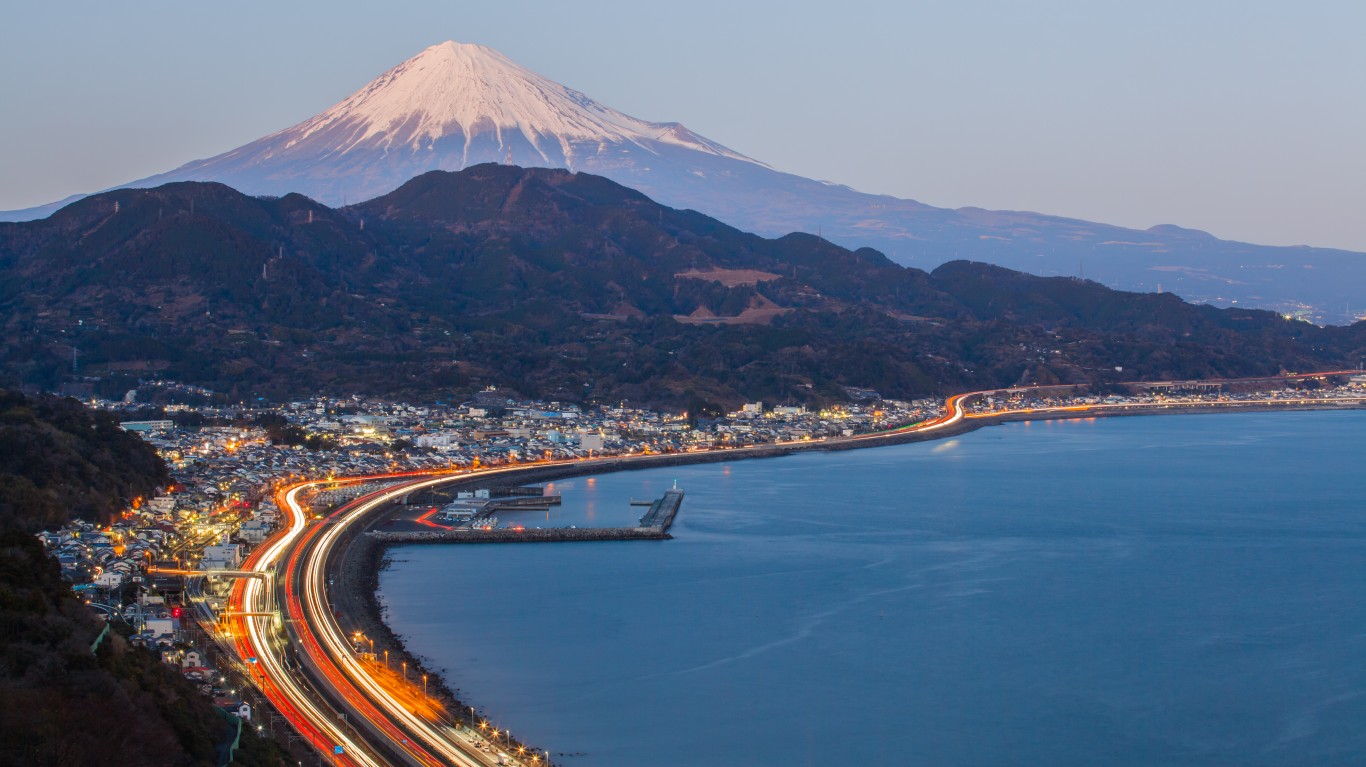
Shizuoka
> Country: Japan
> % destroyed: 66.1%
> Date of attack: June 19, 1945
> Casualties: 1,952
Shizuoka, which was of limited strategic value to the Allies, was bombed 10 times during WWII. After several tactical raids against a defunct Mitsubishi aircraft engine plant earlier in 1945, the U.S. launched a firebombing attack of 137 B-29 bombers on June 19. The bombers attacked from the west and the east to trap the population within the city center, between the mountains and the sea. Two-thirds of the city was destroyed.

Takamatsu
> Country: Japan
> % destroyed: 67.5%
> Date of attack: July 3, 1945
> Casualties: N/A
Takamatsu, a city on the island of Shikoku, was chosen as a target by the Allies because it was considered to be a focal point of Shikoku’s rail and road transit systems, and was the home of some industry essential to the war effort. On July 3, 1945, 128 B-29s dropped more than 800 tons of incendiary bombs on Takamatsu, destorying most of the city.
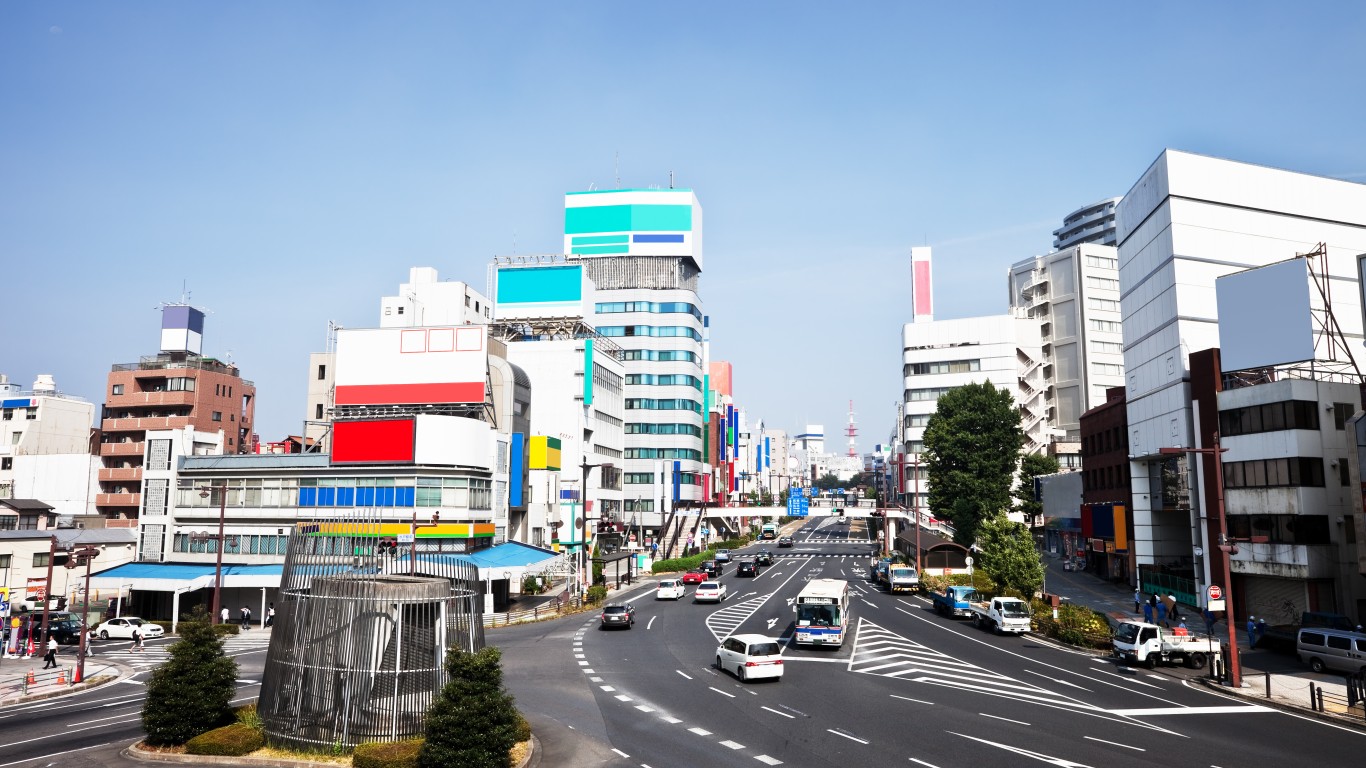
Mito
> Country: Japan
> % destroyed: 68.9%
> Date of attack: Aug. 1, 1945
> Casualties: N/A
With the war winding down, the city of Mito was attacked on Aug. 1, 1945, and almost 70% of the city was destroyed. Mito was about the size of Pontiac, Michigan. The attack was part of a larger raid involving 830 B-29s.
[in-text-ad-2]

Okayama
> Country: Japan
> % destroyed: 68.9%
> Date of attack: June 29, 1945
> Casualties: 1,700
Okayama became one of the most important areas in western Japan for transportation and education before WWII. When the war began, an army base camp was established there. The city was attacked on June 29, 1945, by U.S. bombers carrying incendiary bombs that killed 1,700 people and destroyed almost 70% of the city.
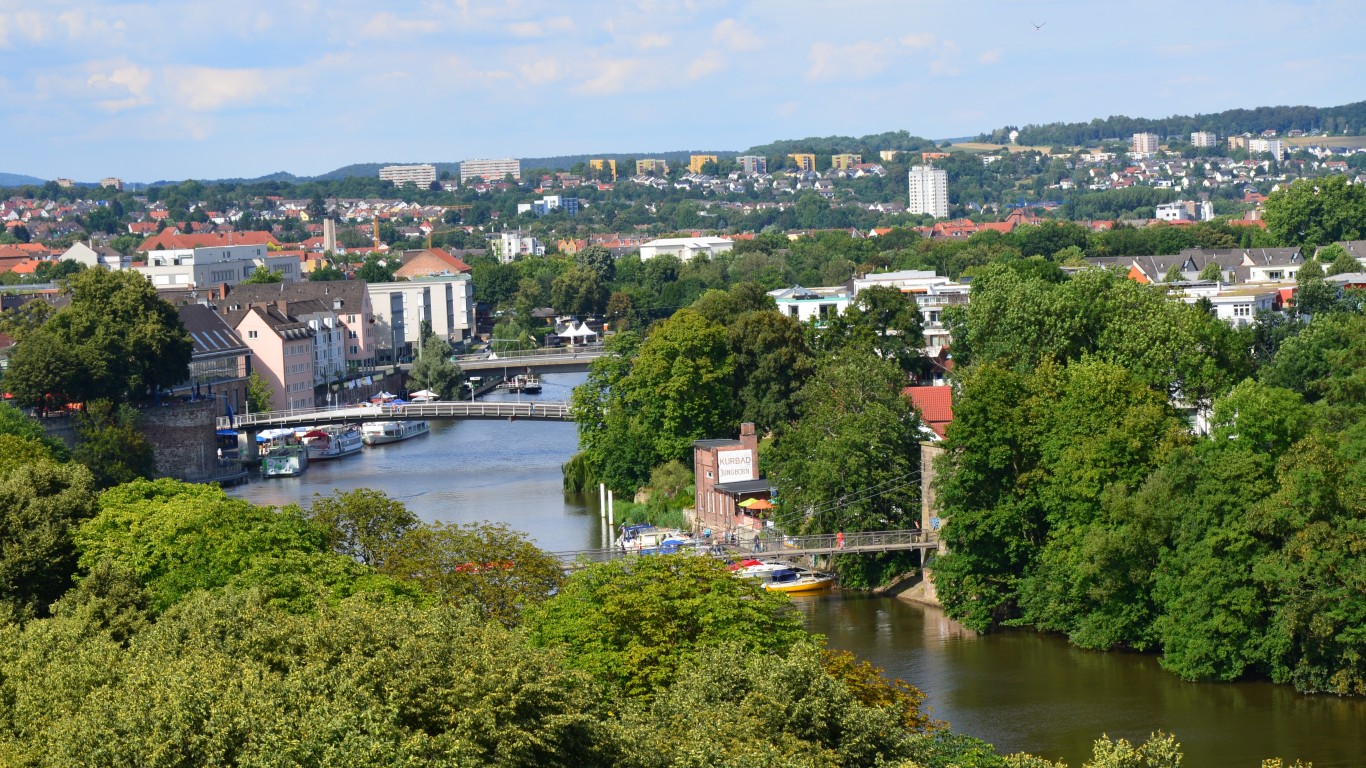
Kassel
> Country: Germany
> % destroyed: 69.0%
> Date of attack: Feb. 1942 – March 1945
> Casualties: 10,000
The site of aircraft and tank plants and other critical German industrial targets, this city in central/western Germany was bombed more than 20 times during the war. A raid on Oct. 22-23, 1943 resulted in a firestorm. The fire of the most severe air raid burned for seven days, at least 10,000 people died, 150,000 inhabitants were bombed-out, and the vast majority of the city center was destroyed.
[in-text-ad]
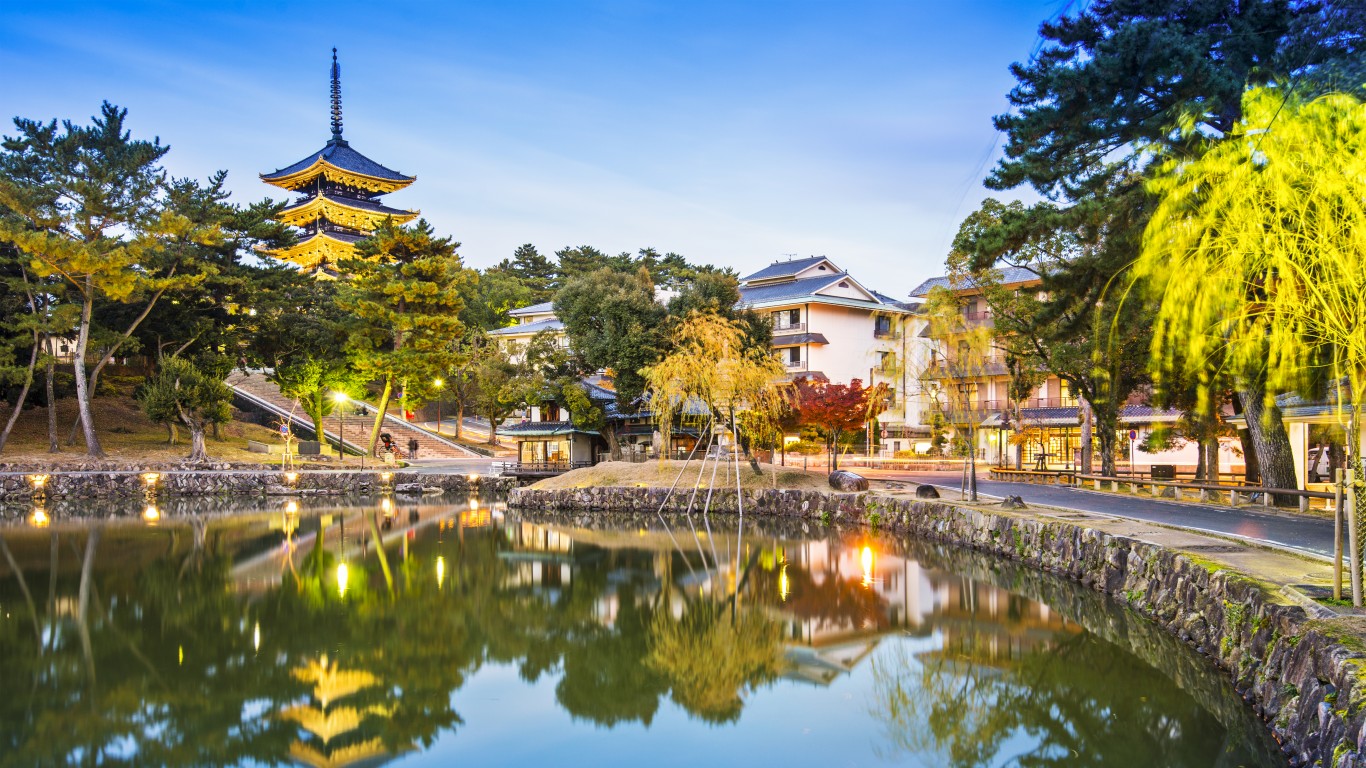
Nara
> Country: Japan
> % destroyed: 69.3%
> Date of attack: June 9, 1945
> Casualties: N/A
Nara was known for its temples and was a great cultural center in Japan. Almost 70% of the city – about the size of Boston – was destroyed.
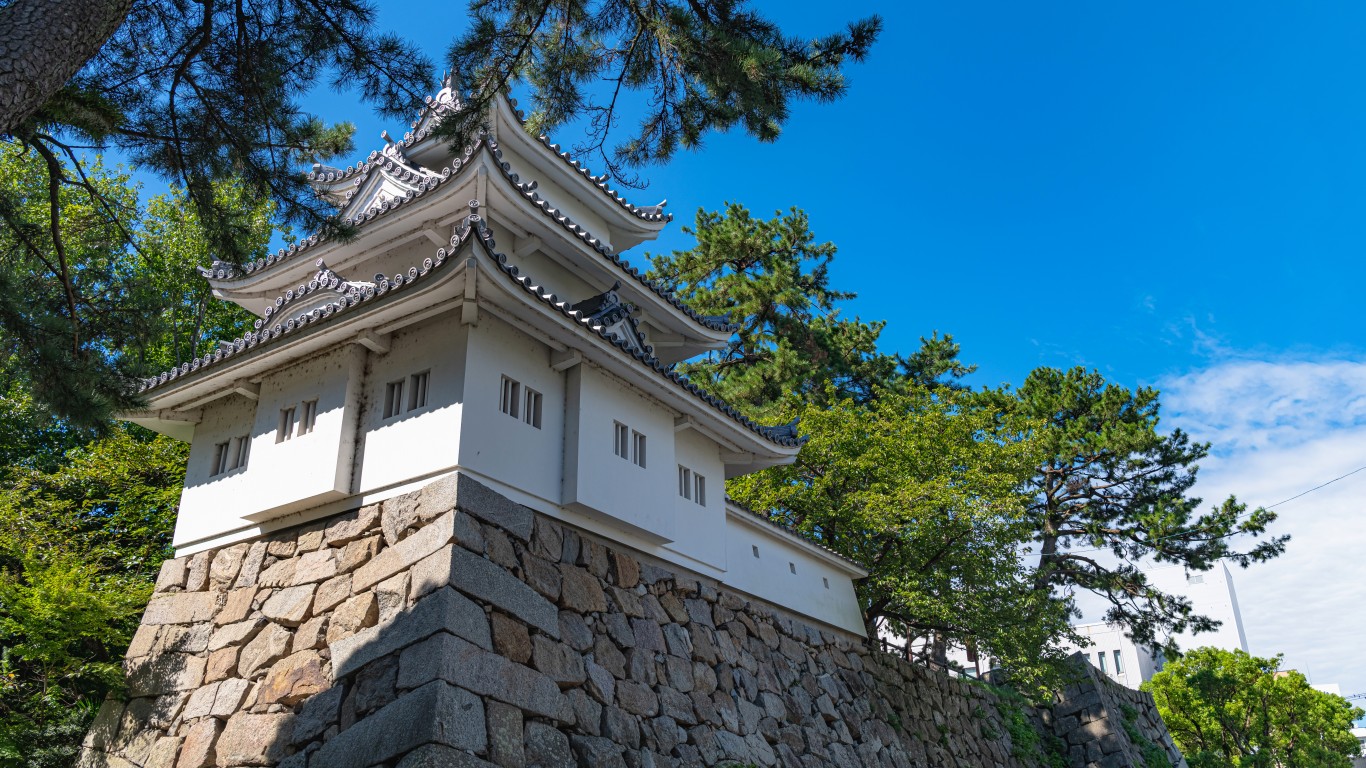
Tsu
> Country: Japan
> % destroyed: 69.3%
> Date of attack: July 28, 1945
> Casualties: N/A
Tsu, about the size of Topeka, Kansas, is on the island of Honshu. Almost 70% damage on July 28, 1945. Tsu was one of six Japanese cities attacked on July 28.
Hitachi
> Country: Japan
> % destroyed: 72.0%
> Date of attack: July 19, 1945
> Casualties: N/A
Hitachi is on the island of Honshu on the Pacific Coast. The city, about the size of Little Rock, sustained damage of 72%. Besides attacks from the air, Hitachi, an important center for electrical equipment, was attacked by U.S. battleships on July 19. They failed to hit factories but killed civilians.
[in-text-ad-2]

Hamburg
> Country: Germany
> % destroyed: 75.0%
> Date of attack: July 24-31, 1943
> Casualties: 37,000
Code-named Operation Gomorrah, a week-long combined U.S. and U.K. air attack on this major German industrial city – home to shipyards, oil refineries, and other operations critical to the Nazi war effort – produced one of the largest firestorms of the war, killing about 37,000 and wounding another 180,000 and leaving the city in ruins.
Kuwana
> Country: Japan
> % destroyed: 75.0%
> Date of attack: July 16, 1945
> Casualties: N/A
Kuwana, in the central part of the island of Honshu, is approximately equivalent in size to Tucson. Kuwana was attacked on July 16, 1945, and 75% of the city was destroyed.
[in-text-ad]

Koblenz
> Country: Germany
> % destroyed: 80.0%
> Date of attack: Nov. 16, 1944
> Casualties: N/A
Koblenz, on the banks of the Rhine and Moselle rivers, hosted the command of German Army Group B, and as such it was a target of Allied bombing. The city suffered severe aerial bombardment leading to the loss of much of its historic heritage.
Fukuyama
> Country: Japan
> % destroyed: 80.9%
> Date of attack: Aug. 8, 1945
> Casualties: N/A
Fukuyama, the largest city in the Hiroshima Prefecture after Hiroshima itself, was known for its 17th-century castle. The city was heavily damaged by Allied bombing two days after the atomic bomb attack on Hiroshima. The attack largely destroyed the castle, but it was restored when the city industrialized after the war.
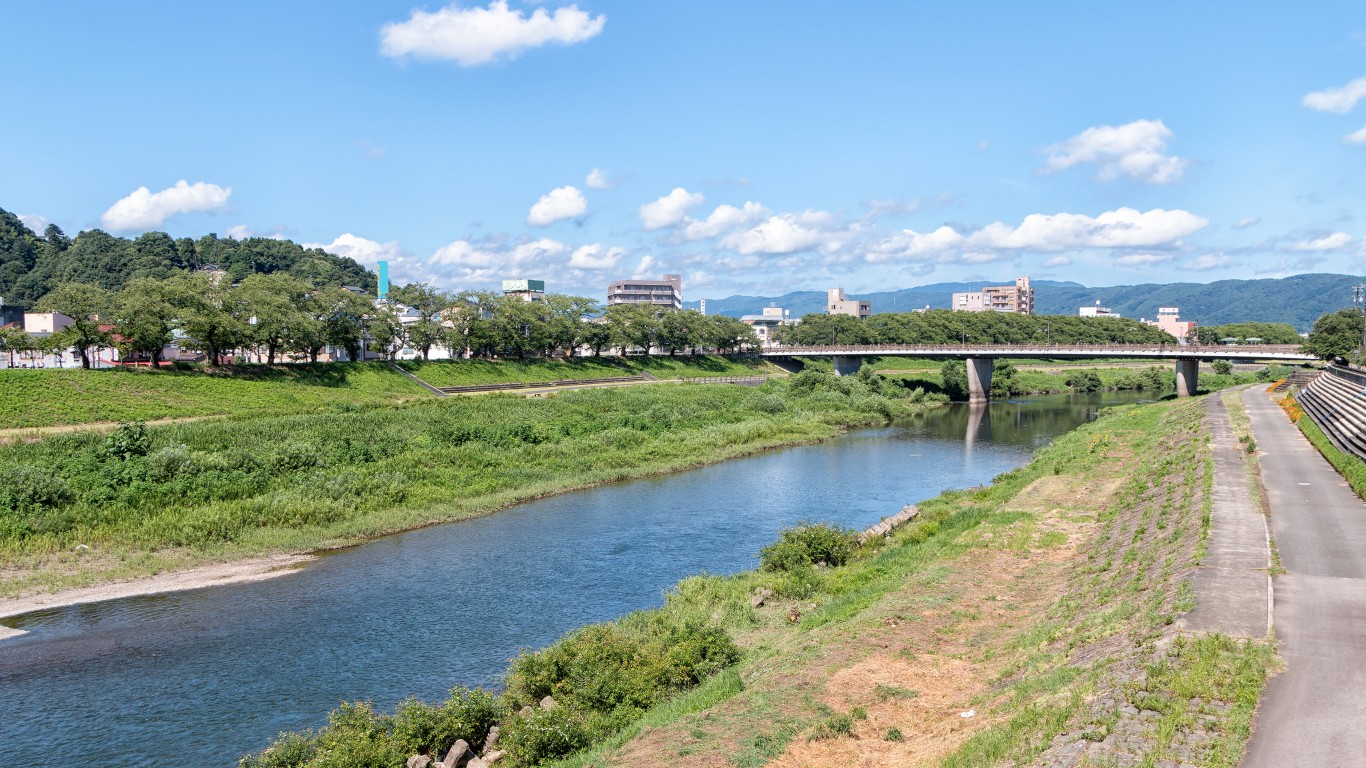
Fukui
> Country: Japan
> % destroyed: 84.8%
> Date of attack: July 19, 1945
> Casualties: 1,576
On July 19, 1945, 133 Boeing B-29s launched from Tinian in the Marianas dropped incendiary bombs in a spiral pattern with a radius of almost a mile around the northwest of the city, leaving it in ruins. A firestorm resulted and destroyed most of the city.
[in-text-ad-2]
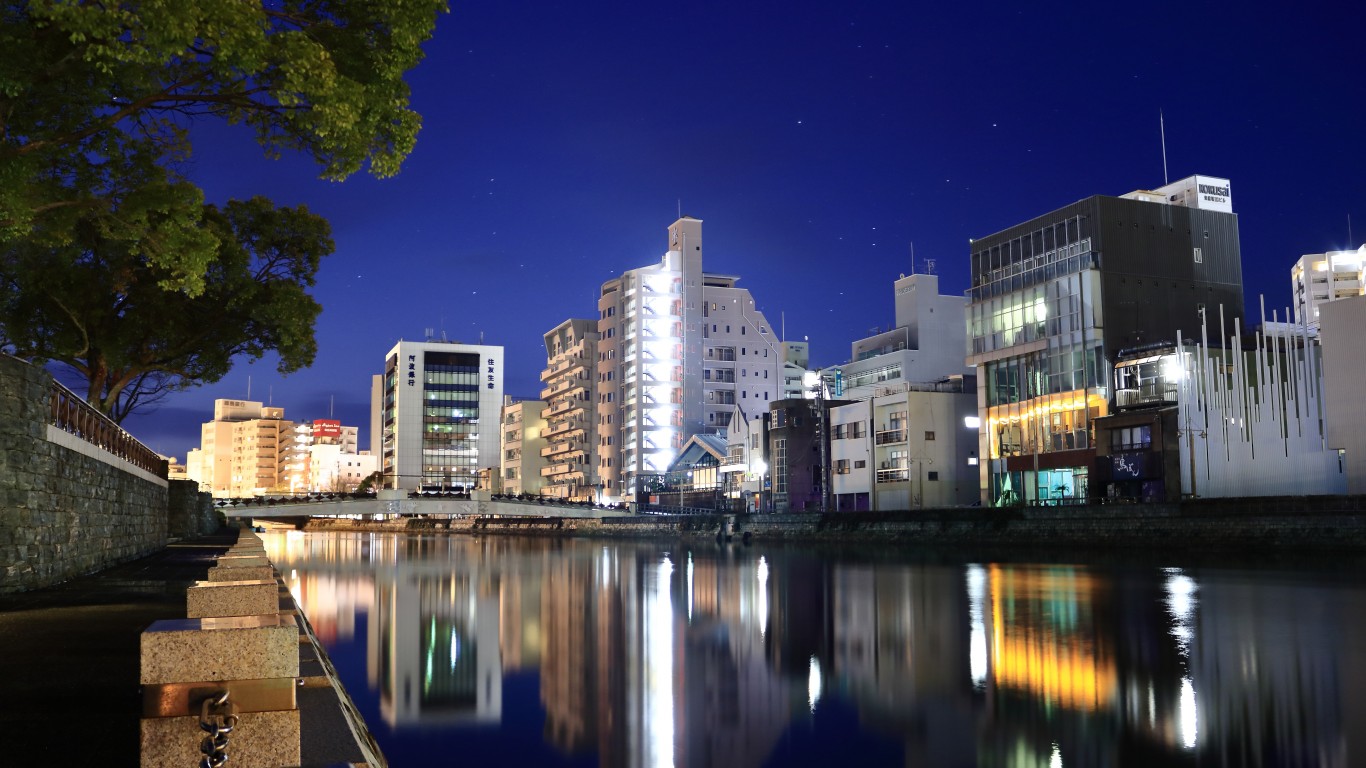
Tokushima
> Country: Japan
> % destroyed: 85.2%
> Date of attack: July 3, 1945
> Casualties: 1,000
The bombing of Tokushima, the capital city of Tokushima Prefecture on Shikoku island, began on the eve of the American Independence Day. Incendiary bombs from American B-29s destroyed more than 85% of the city, and 1,000 people were killed.
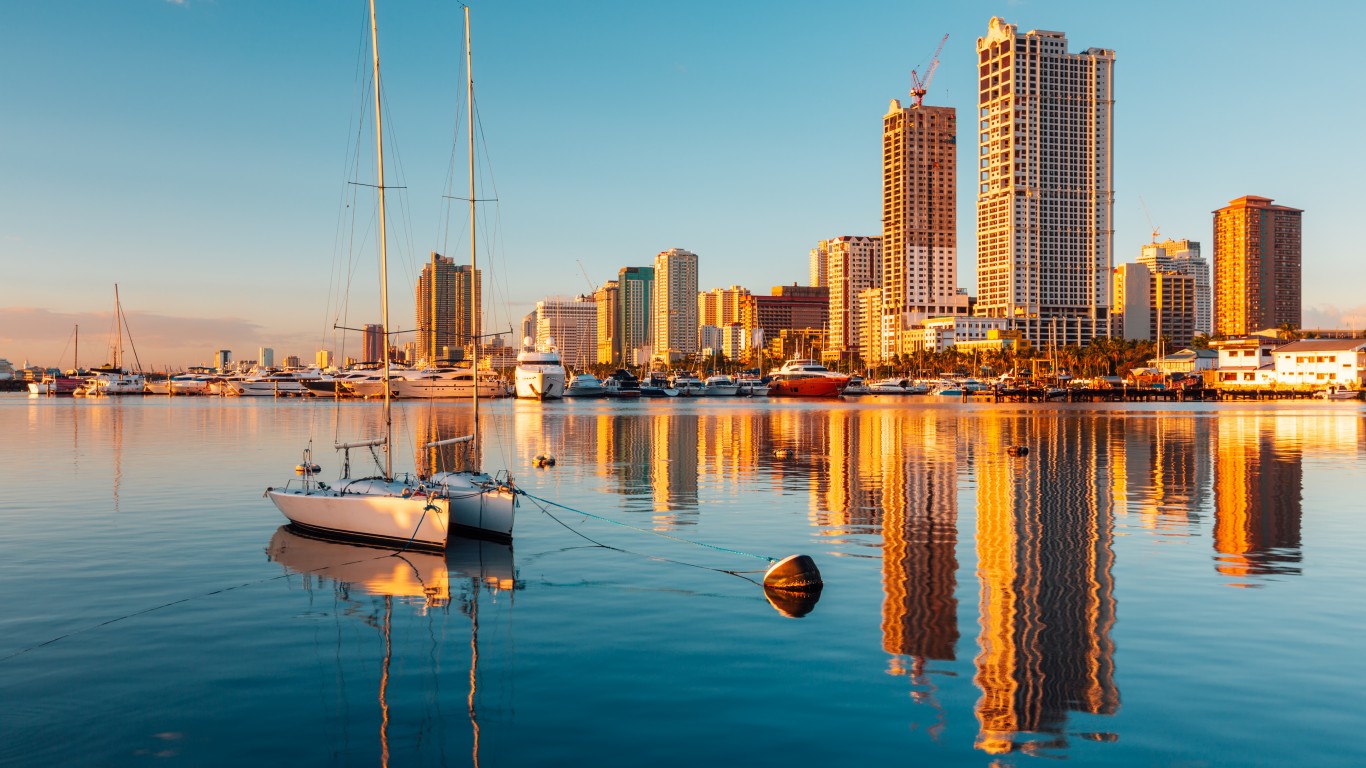
Manila
> Country: Philippines
> % destroyed: 90.0%
> Date of attack: Feb. 3-March 3, 1945
> Casualties: -140,000
In a rare instance in WWII of a city destroyed by other than aerial bombing, artillery and cannon fire from tanks destroyed the old city of Manila, the site of extensive urban combat in 1945, as American and Filipino troops expelled the Japanese from the Philippines capital.
[in-text-ad]

Nuremberg
> Country: Germany
> % destroyed: 90.0%
> Date of attack: Jan. 2, 1945
> Casualties: 1,800
The bombing of Nuremberg was a series of air raids carried out by allied forces of the Royal Air Force and the United States Army Air Forces that caused heavy damage throughout the city from 1940 through 1945. Nuremberg was a vital economic and infrastructural hub and also held symbolic importance as the seat of Nazism and the site of major Nazi rallies.
Saint-Lô
> Country: France
> % destroyed: 95.0%
> Date of attack: July 7-19, 1944
> Casualties: 1,000
The French city of Saint-Lô, strategically important as a crossroads, was heavily damaged by American planes during and after the Normandy invasion in 1944 as the Allies tried to enlarge their toehold on the beaches of Normandy. German targets were largely missed and most of the damage and casualties fell on French citizens.
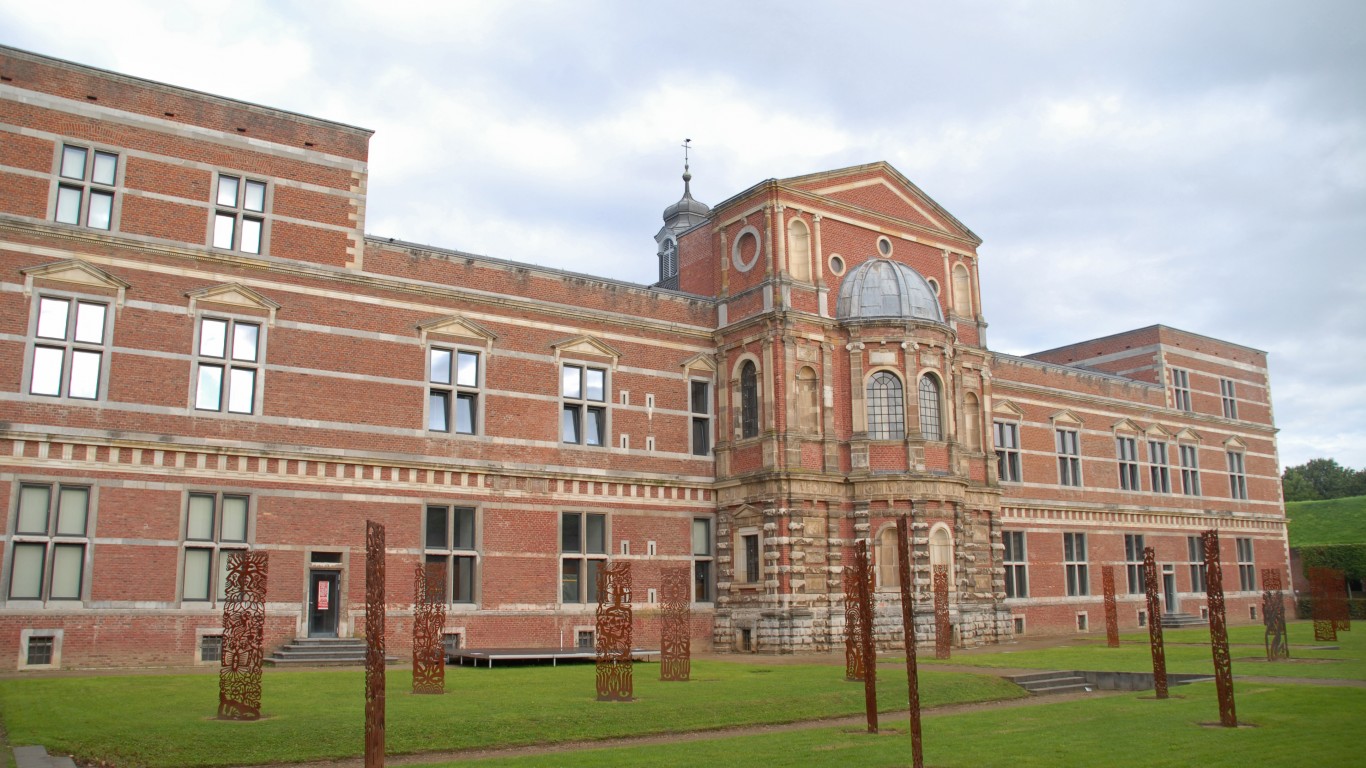
Jülich
> Country: Germany
> % destroyed: 97.0%
> Date of attack: Nov. 16, 1944
> Casualties: 1,000
The medieval town of Jülich, on a crossing of the River Rur in what is now the state of North Rhine-Westphalia, suffered some of the most intense batterings of the war, with 97% of the town lost to bombing in 1944 and the remaining 3% destroyed after three months of fighting. After the war, the town was rebuilt.
[in-text-ad-2]
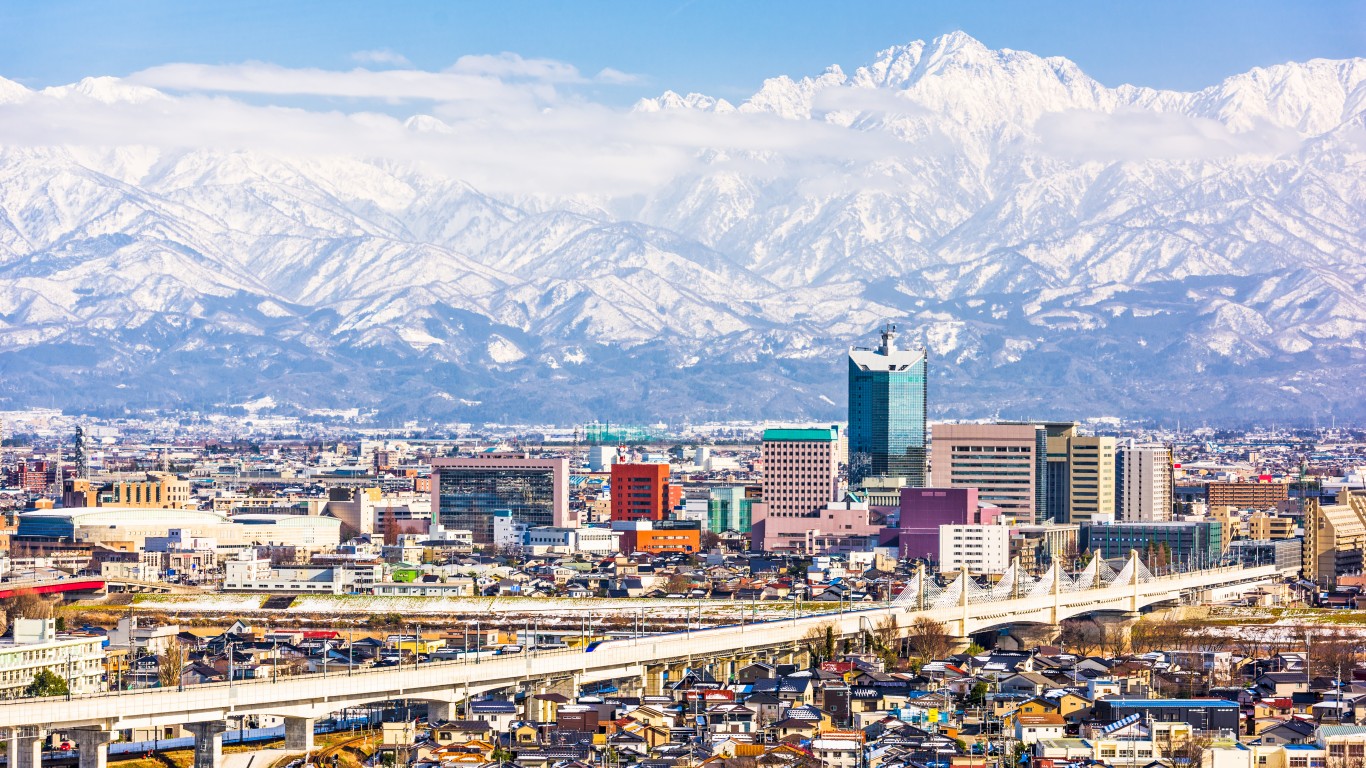
Toyama
> Country: Japan
> % destroyed: 99.0%
> Date of attack: Aug. 1, 1945
> Casualties: 2,149
Toyama, on the coast of the Sea of Japan in the Chūbu region on central Honshū island, was hit by 173 B-29s on Aug. 1 as part of a larger raid on cities that included Hachiōji, Mito, and Nagaoka. Toyama, a major producer of aluminum, was especially hard hit, with some 99% of its area destroyed.
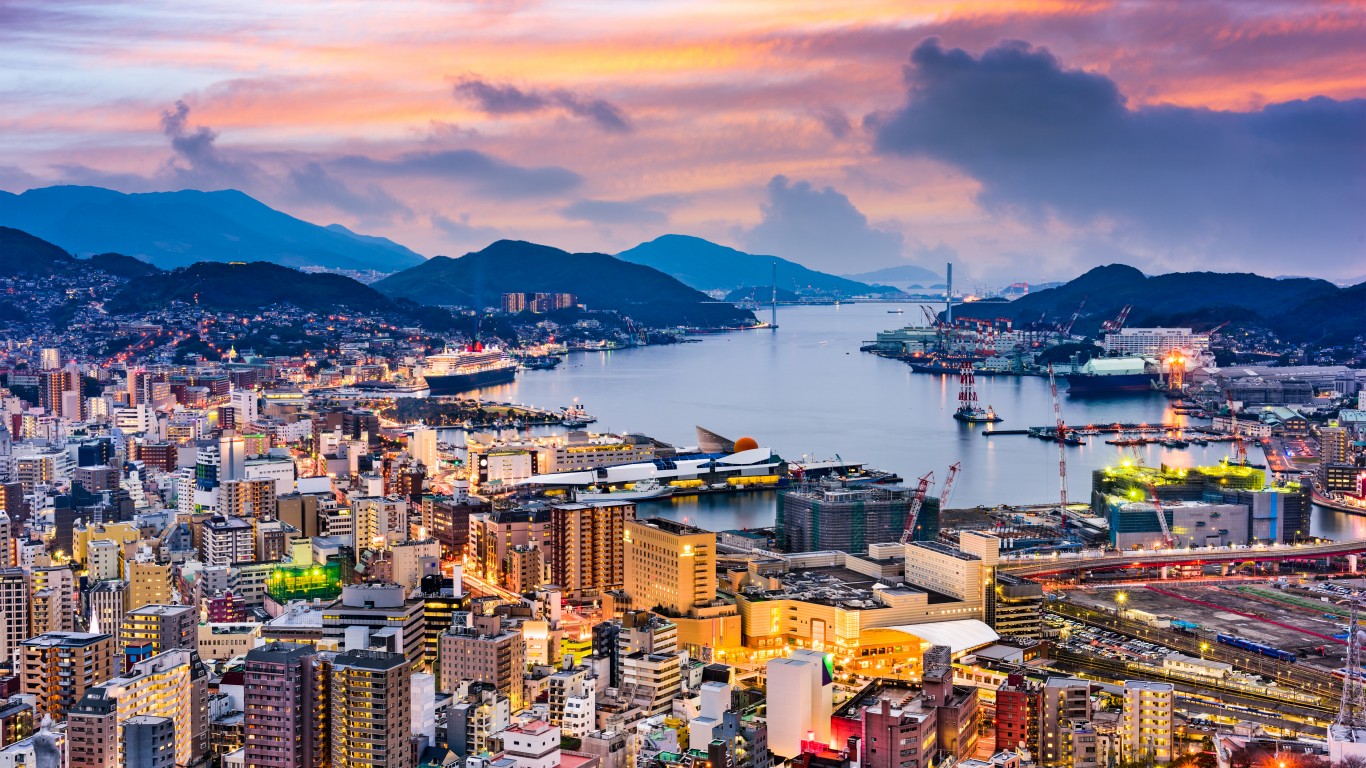
Nagasaki
> Country: Japan
> % destroyed: 100.0%
> Date of attack: Aug. 9, 1945
> Casualties: 39,000
Nagasaki, in eastern Japan, and about the size of Akron, Ohio, was the site of the second atomic bomb attack on Aug. 9. It obliterated the city and killed 39,000. The second nuclear attack was a factor in prodding Japan to surrender five days later.
[in-text-ad]

Hiroshima
> Country: Japan
> % destroyed: 100.0%
> Date of attack: Aug. 6, 1945
> Casualties: 66,000
The world’s first atomic bomb attack occurred in Hiroshima on Aug. 6, 1945, when the city was virtually wiped off the map and 66,000 people perished. The use of atomic weapons began a debate that continues to this day.
Methodology
To identify the cities destroyed by the United States during WWII, 24/7 Wall St. used a variety of historical sources to confirm the dates, locations, and affected area of the cities most devastated by the bombing campaignes by the United States and the other Allied nations. We considered cities where over 50% of the city was destroyed, or had significant reported casualties.
Are You Ahead, or Behind on Retirement?
If you’re one of the over 4 Million Americans set to retire this year, you may want to pay attention. Many people have worked their whole lives preparing to retire without ever knowing the answer to the most important question: am I ahead, or behind on my goals?
Don’t make the same mistake. It’s an easy question to answer. A quick conversation with a financial advisor can help you unpack your savings, spending, and goals for your money. With Zoe Financial’s free matching tool, you can connect with trusted financial advisors in minutes.
Why wait? Click here to get started today!
Thank you for reading! Have some feedback for us?
Contact the 24/7 Wall St. editorial team.
 24/7 Wall St.
24/7 Wall St.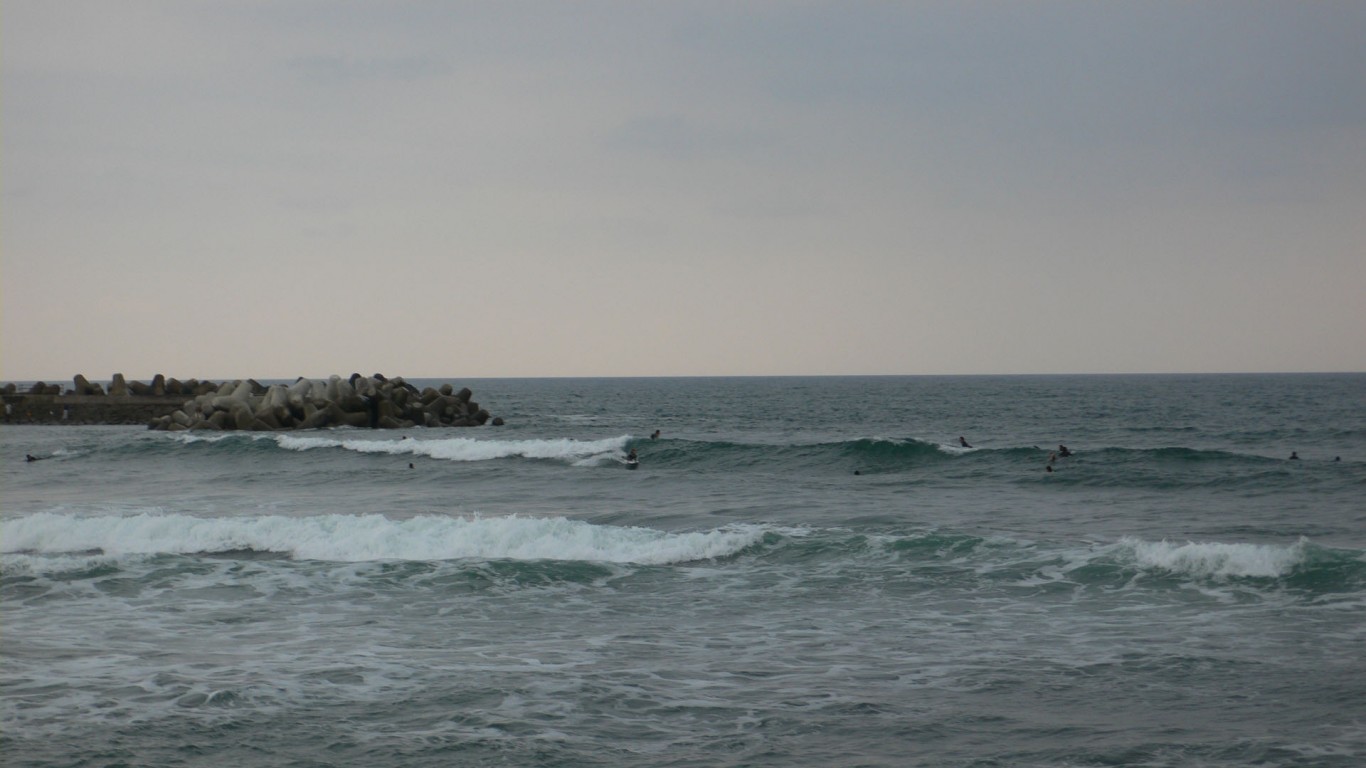

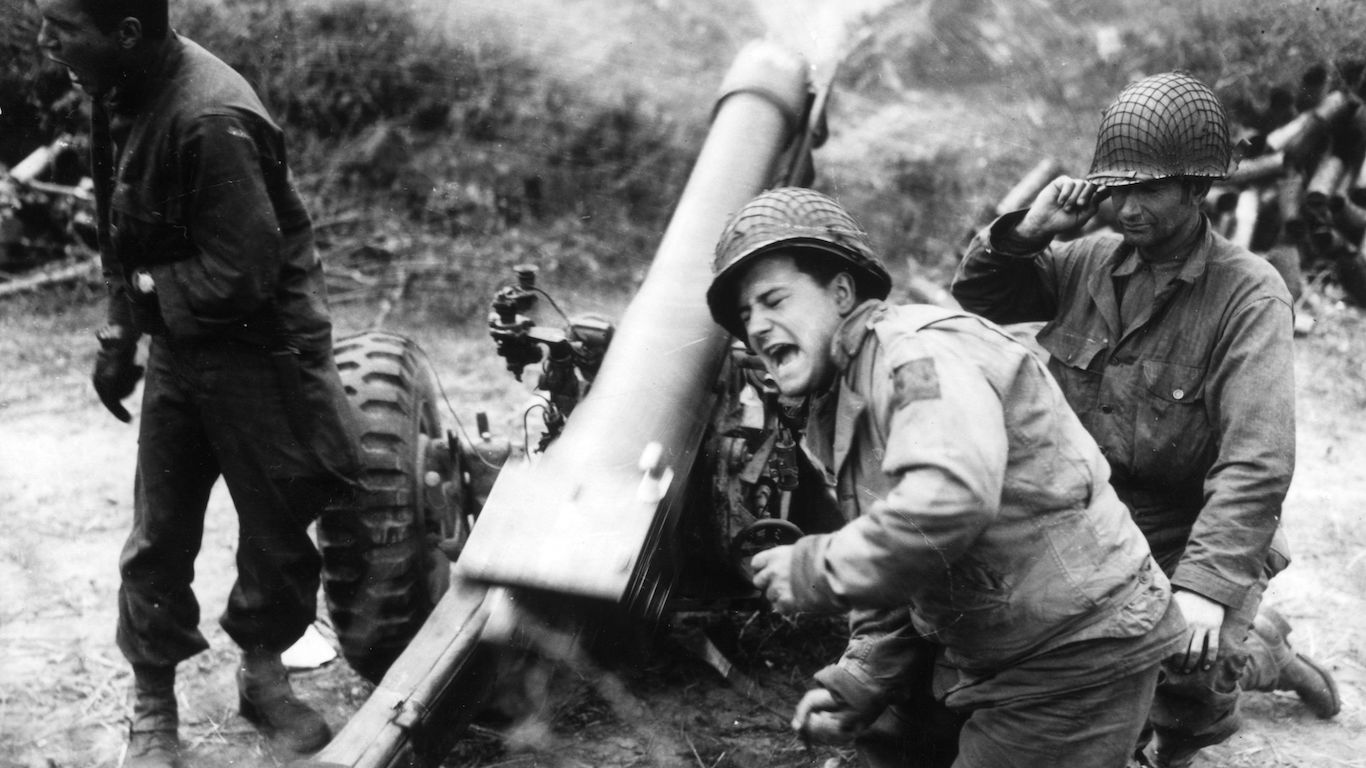 24/7 Wall St.
24/7 Wall St.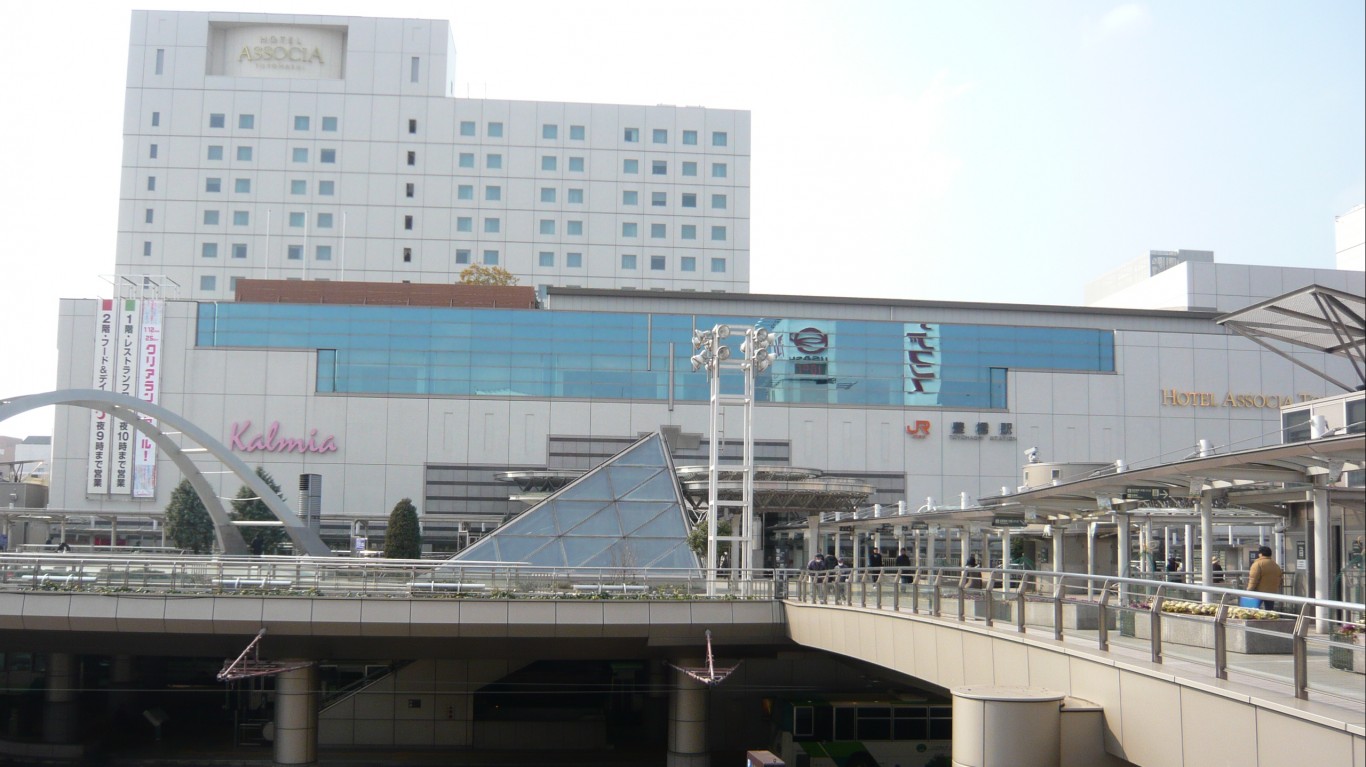
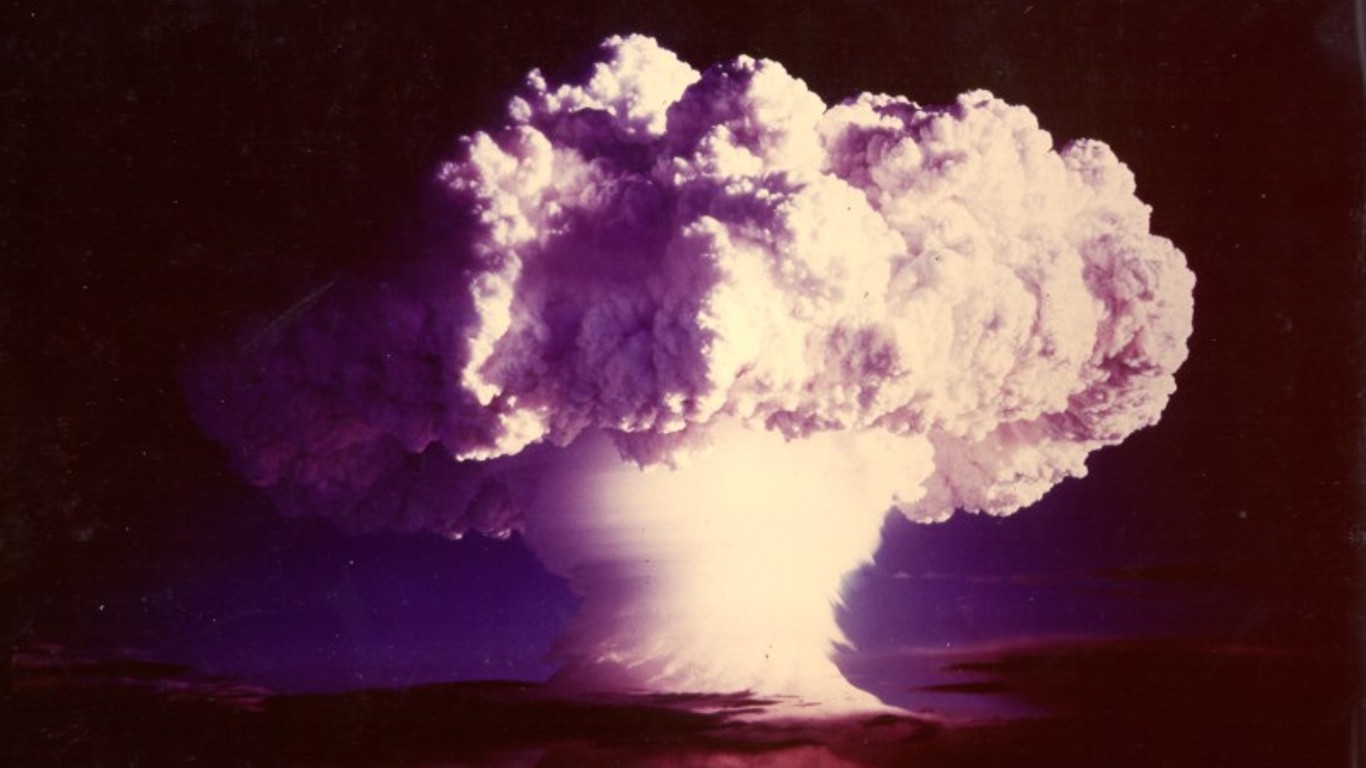 24/7 Wall St.
24/7 Wall St.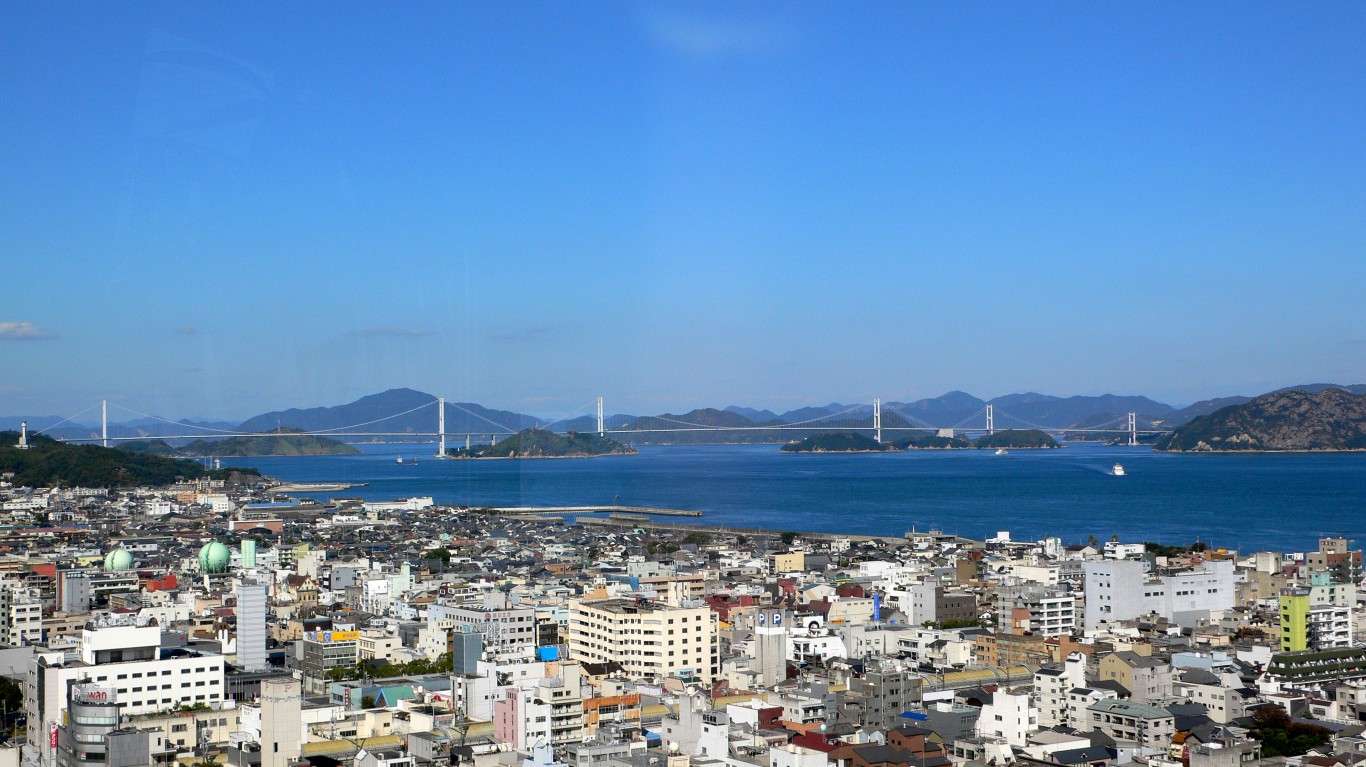
 24/7 Wall St.
24/7 Wall St.